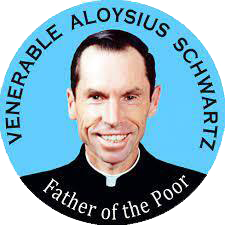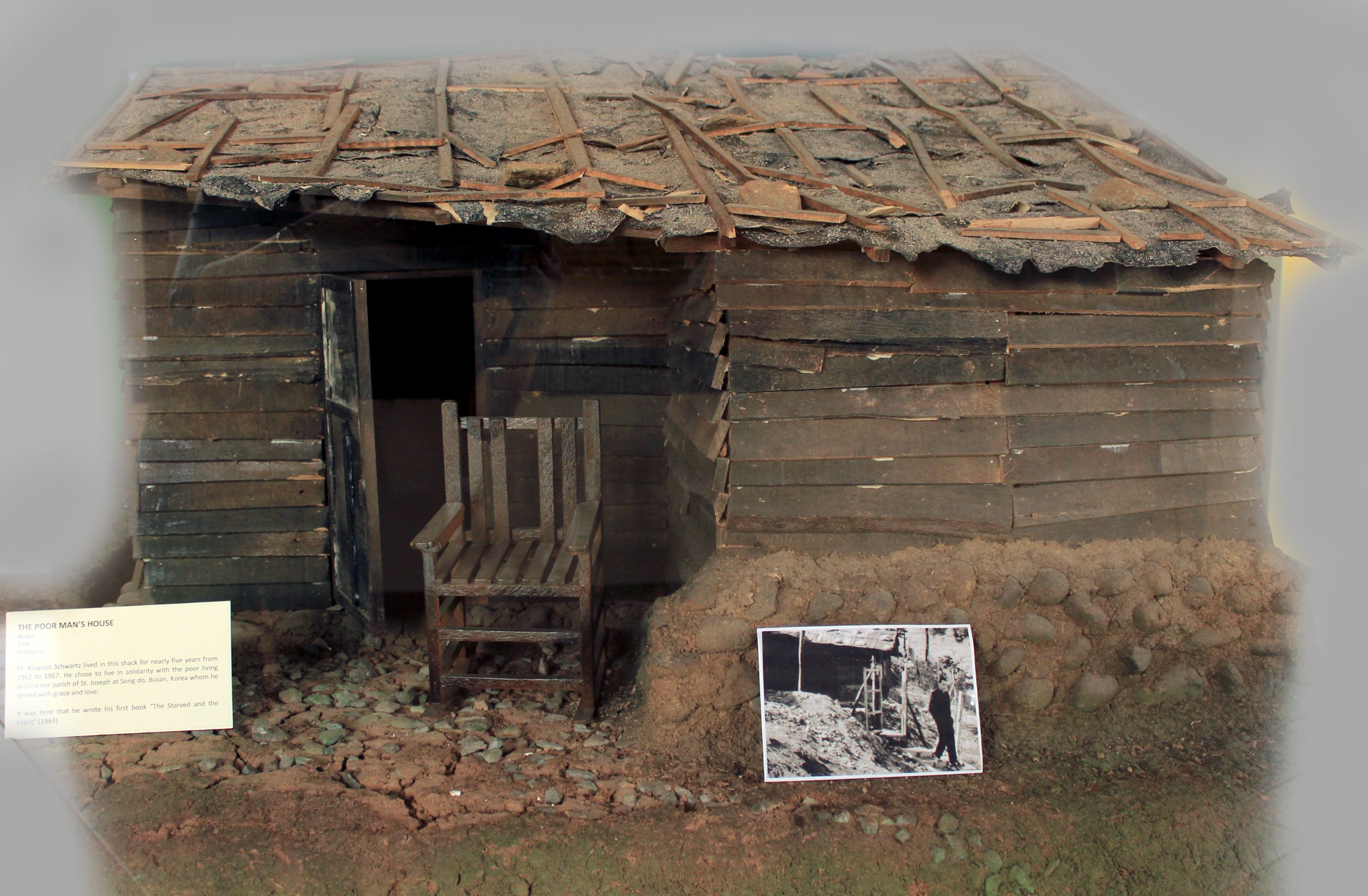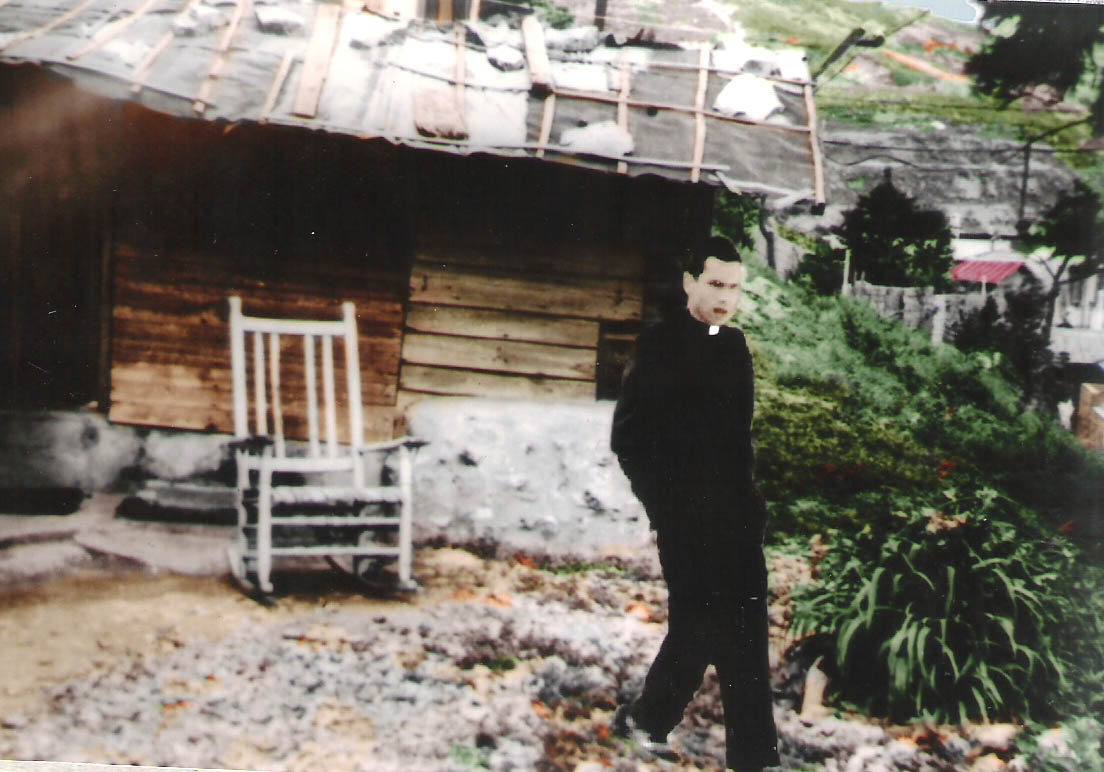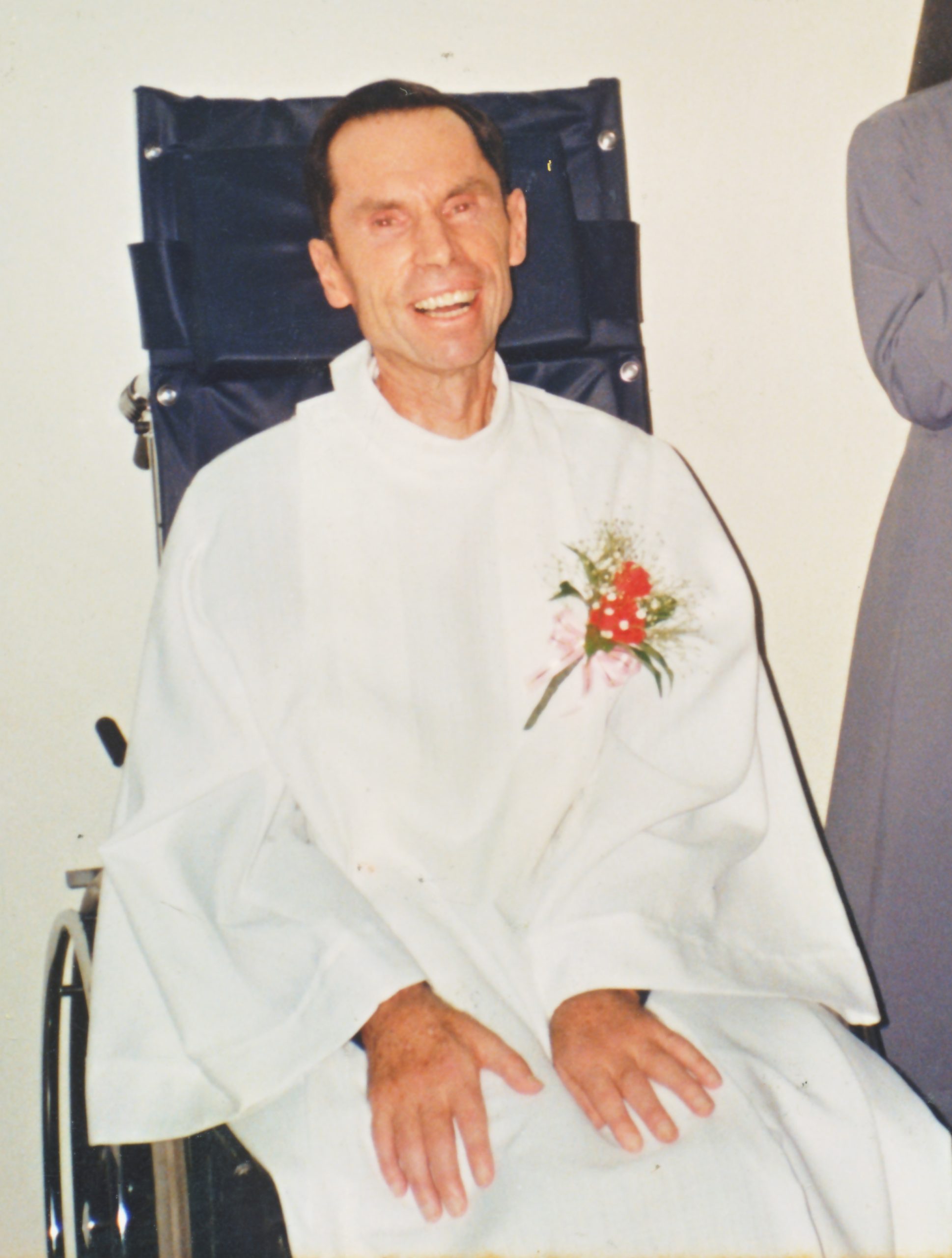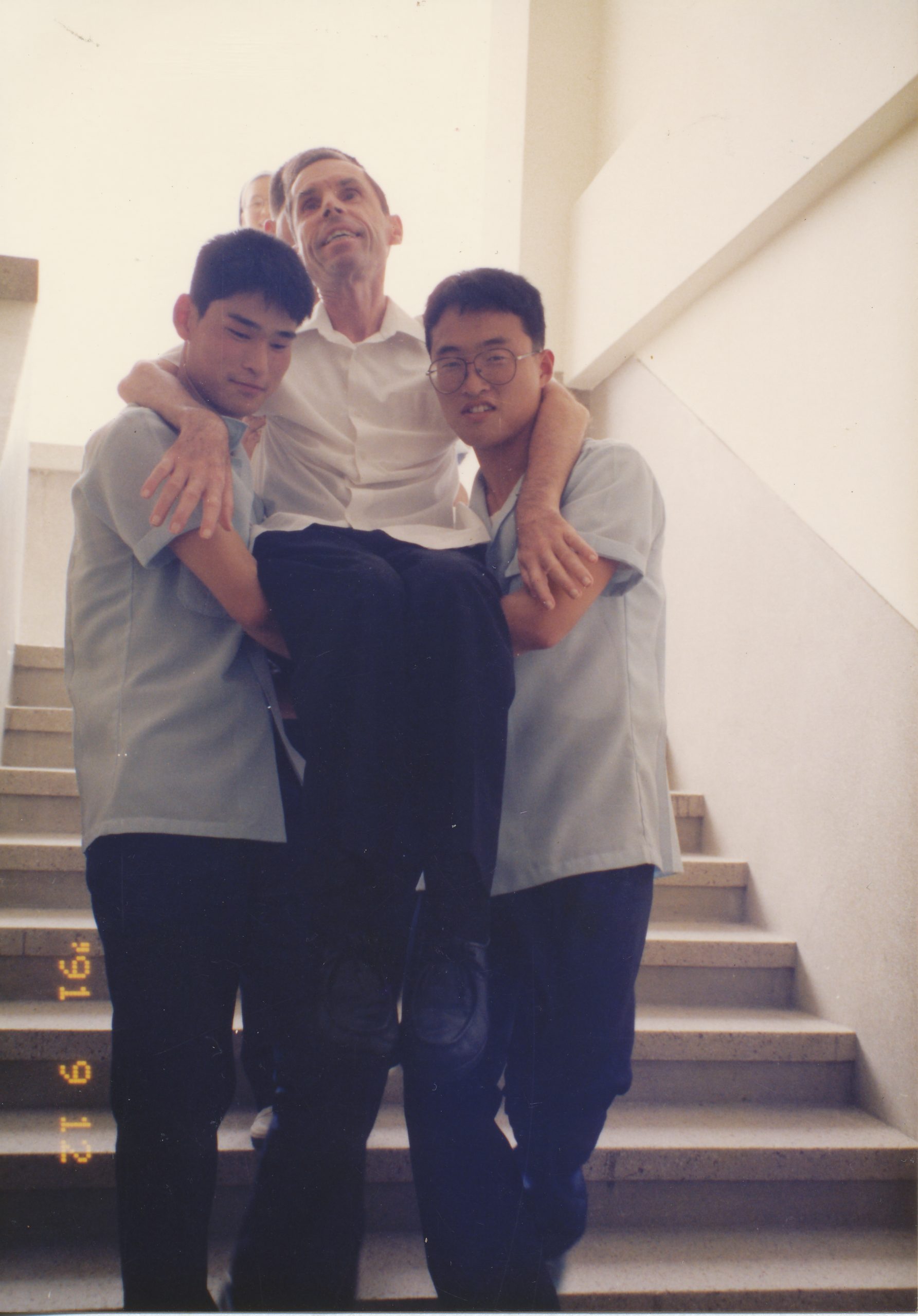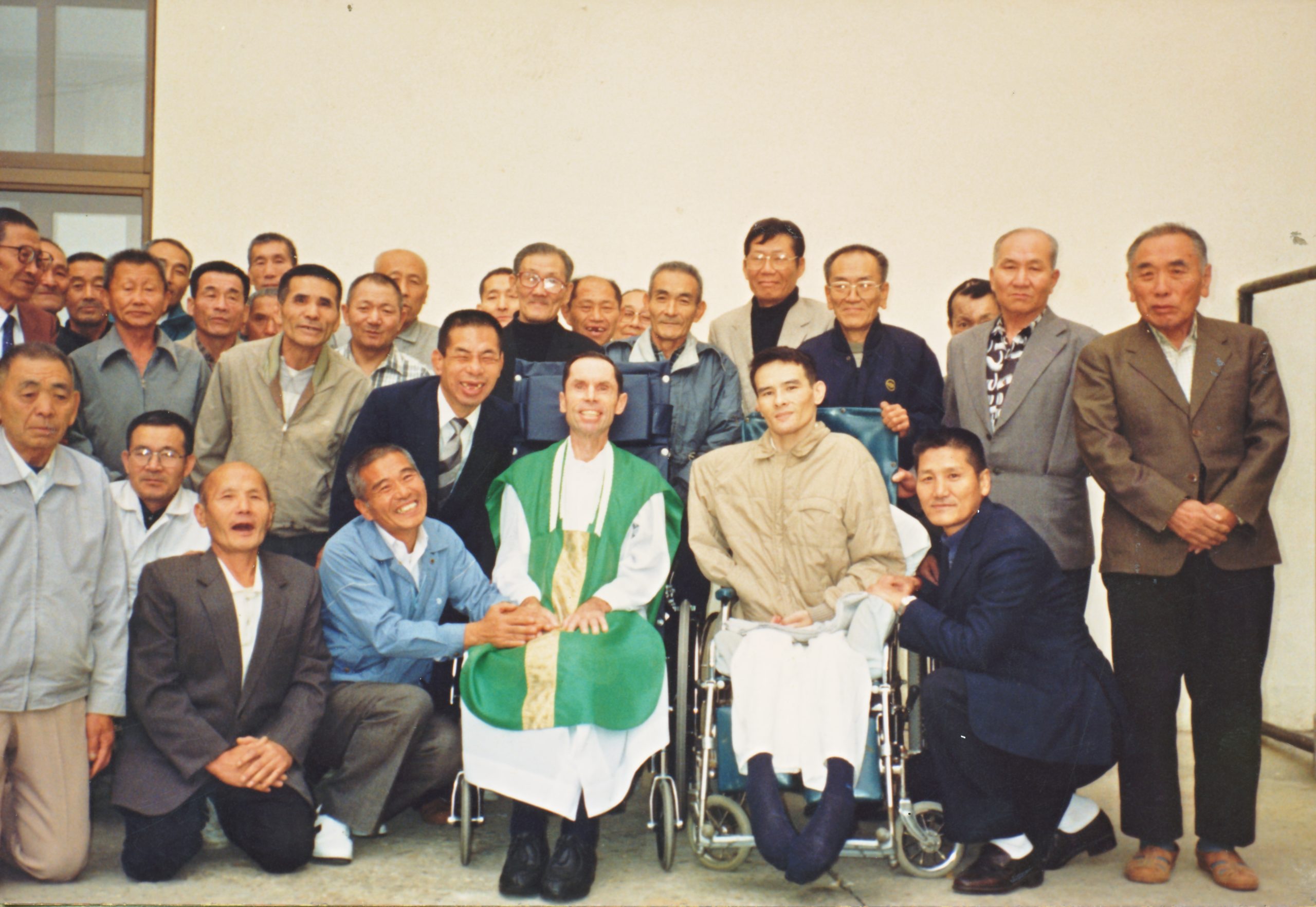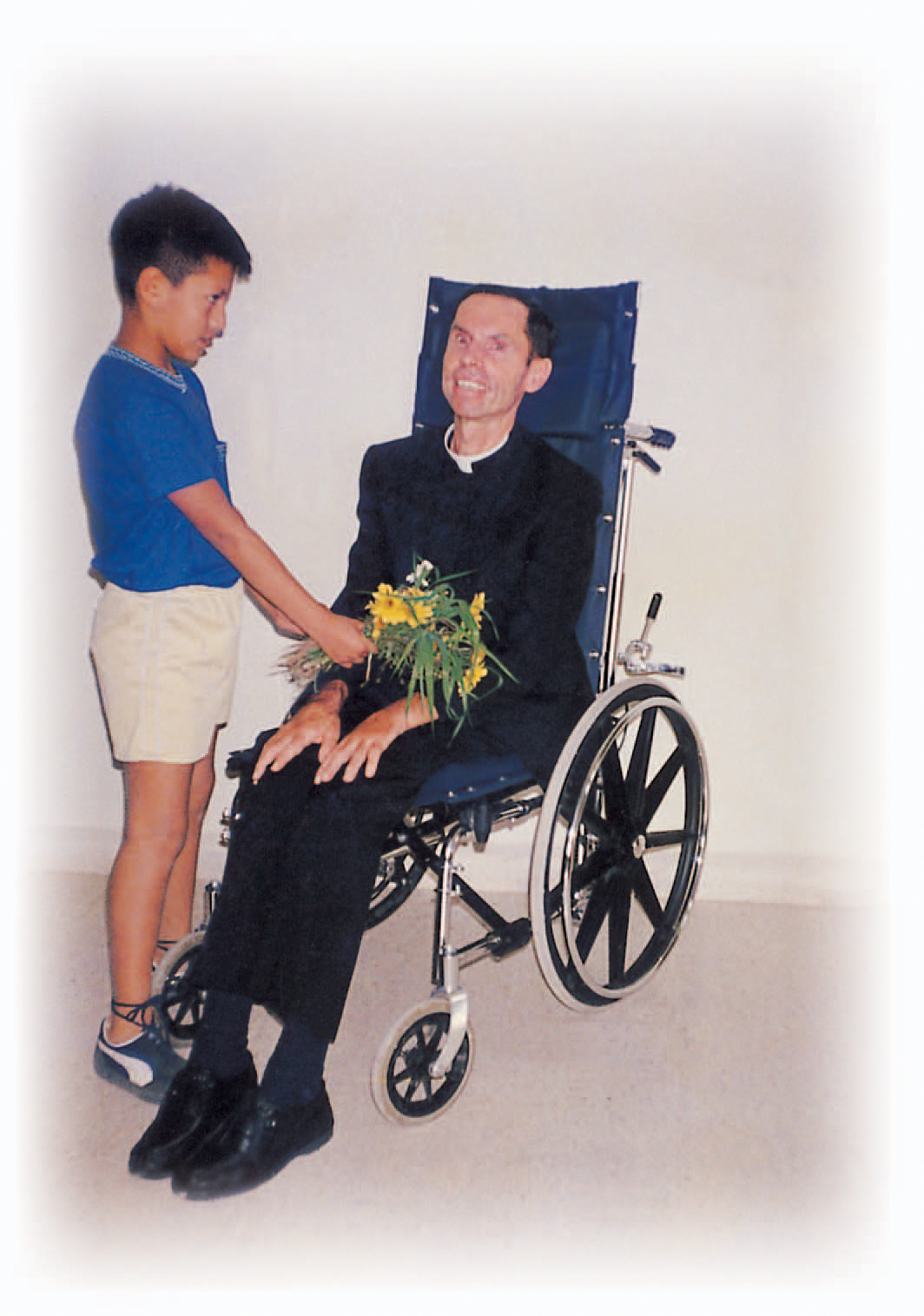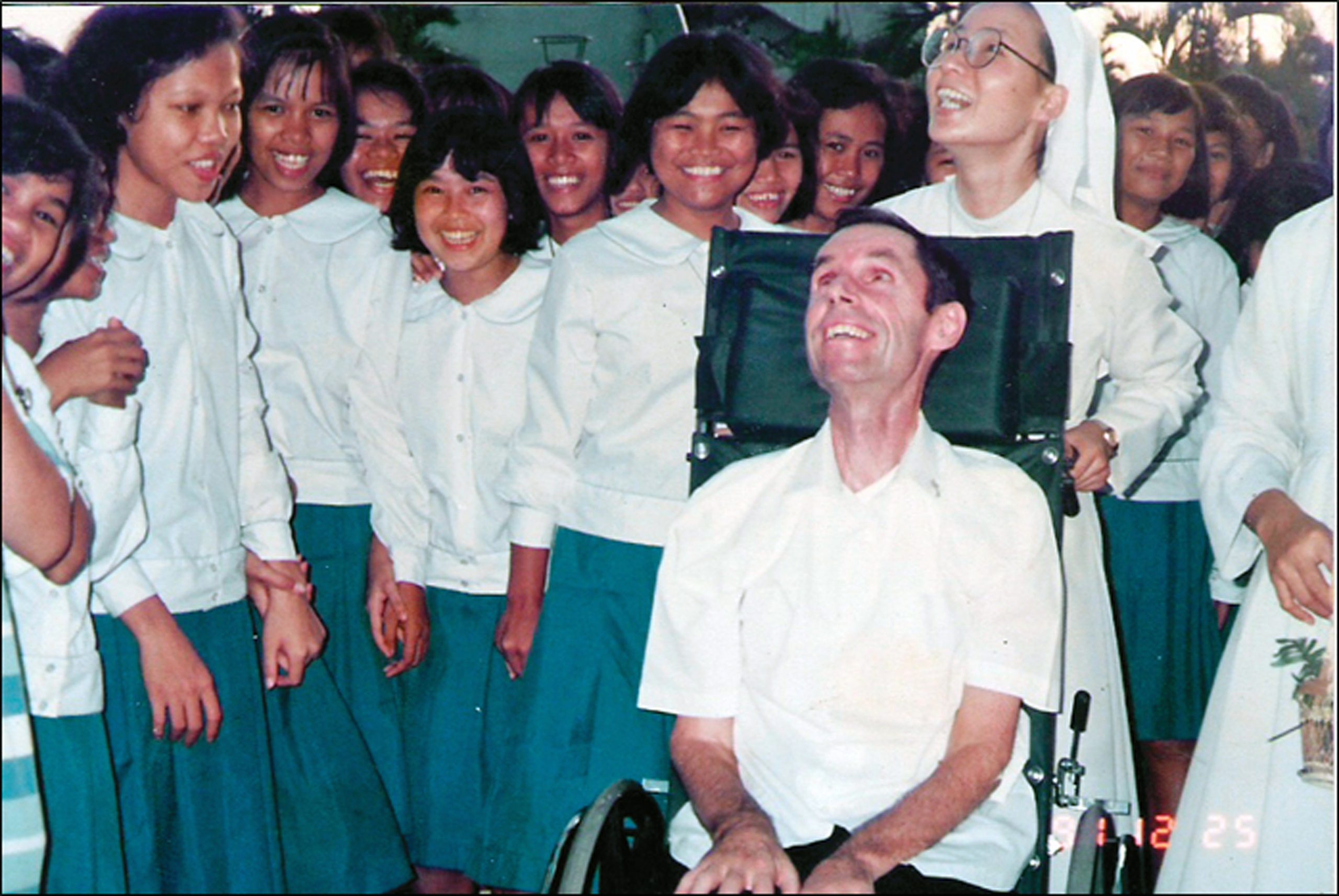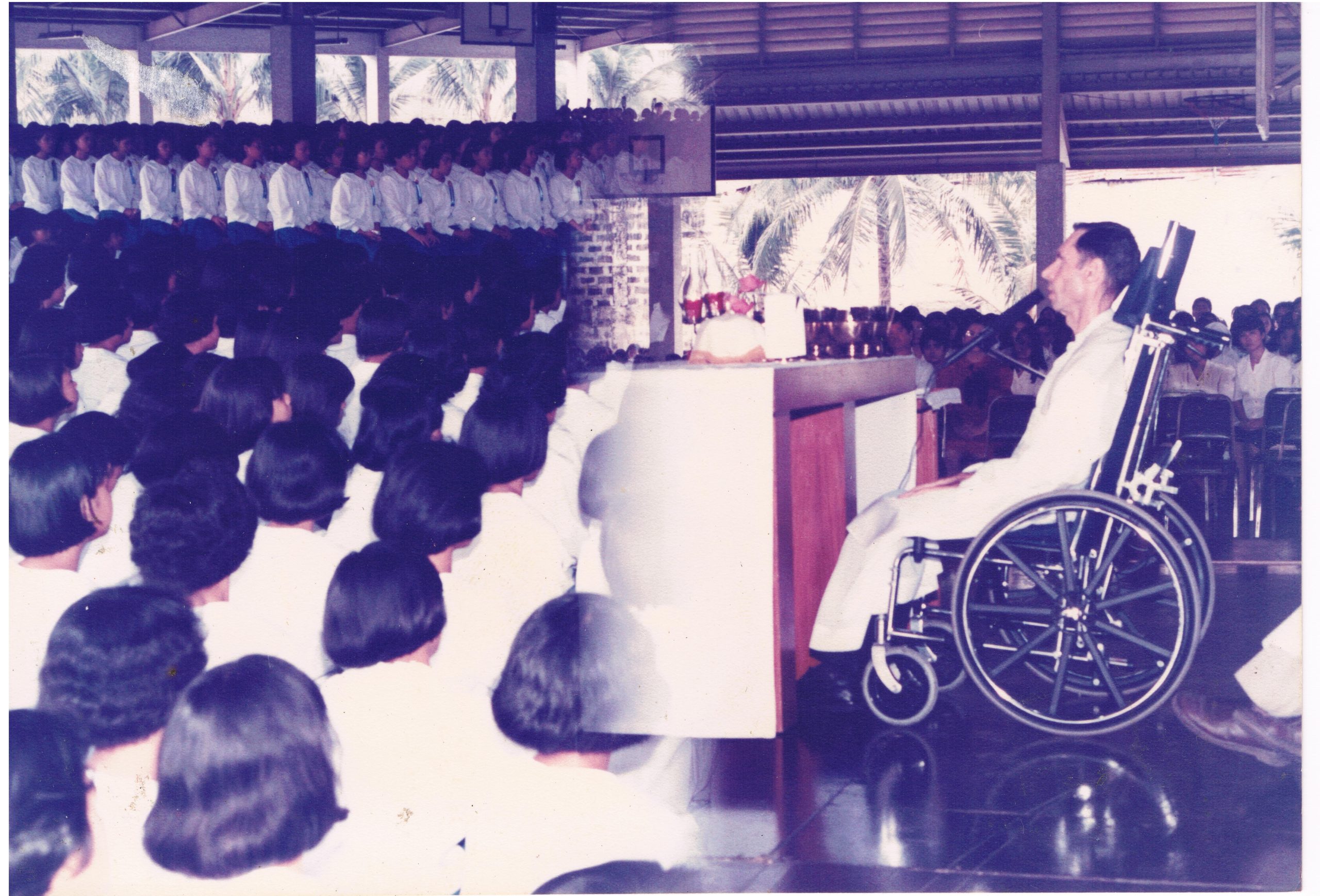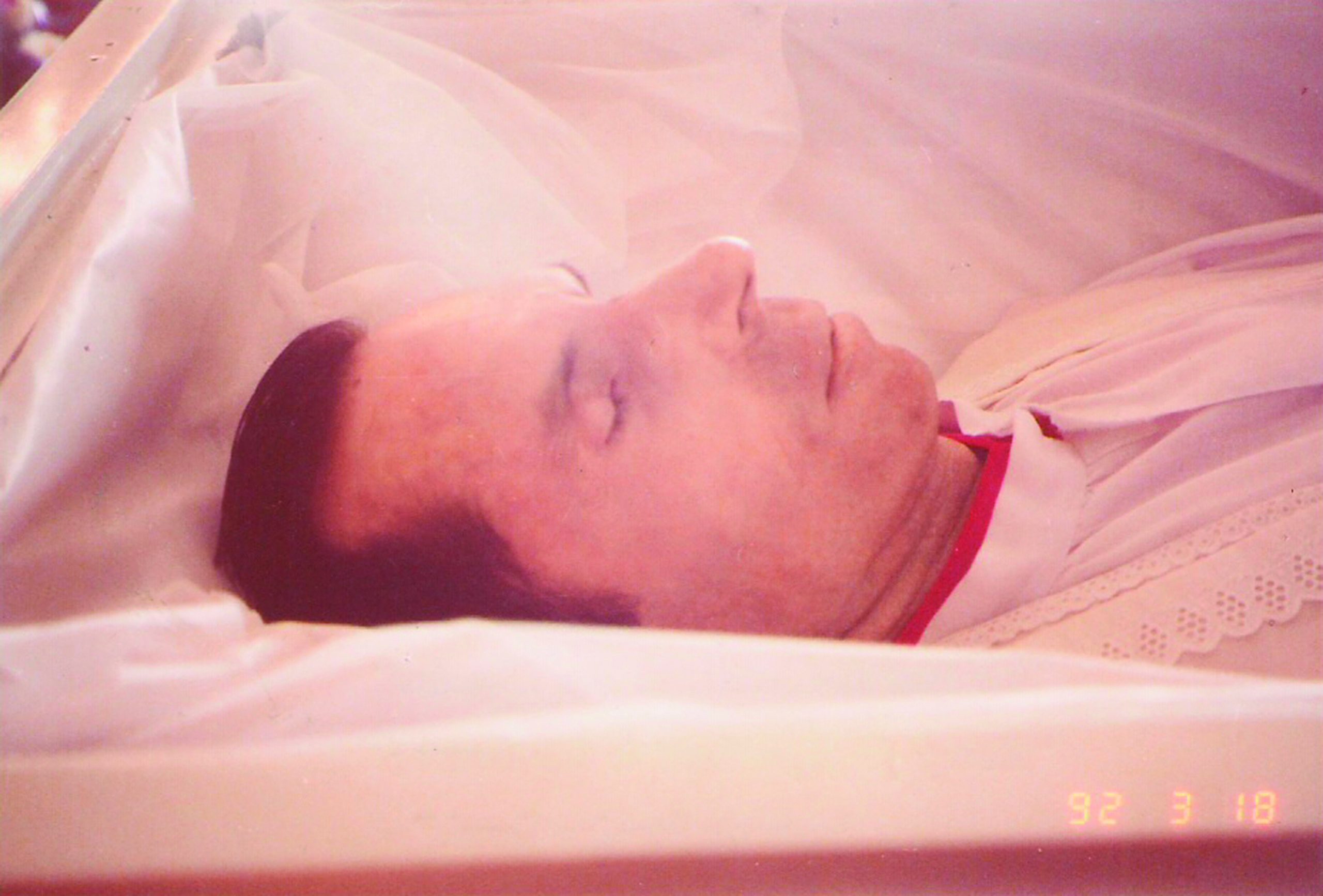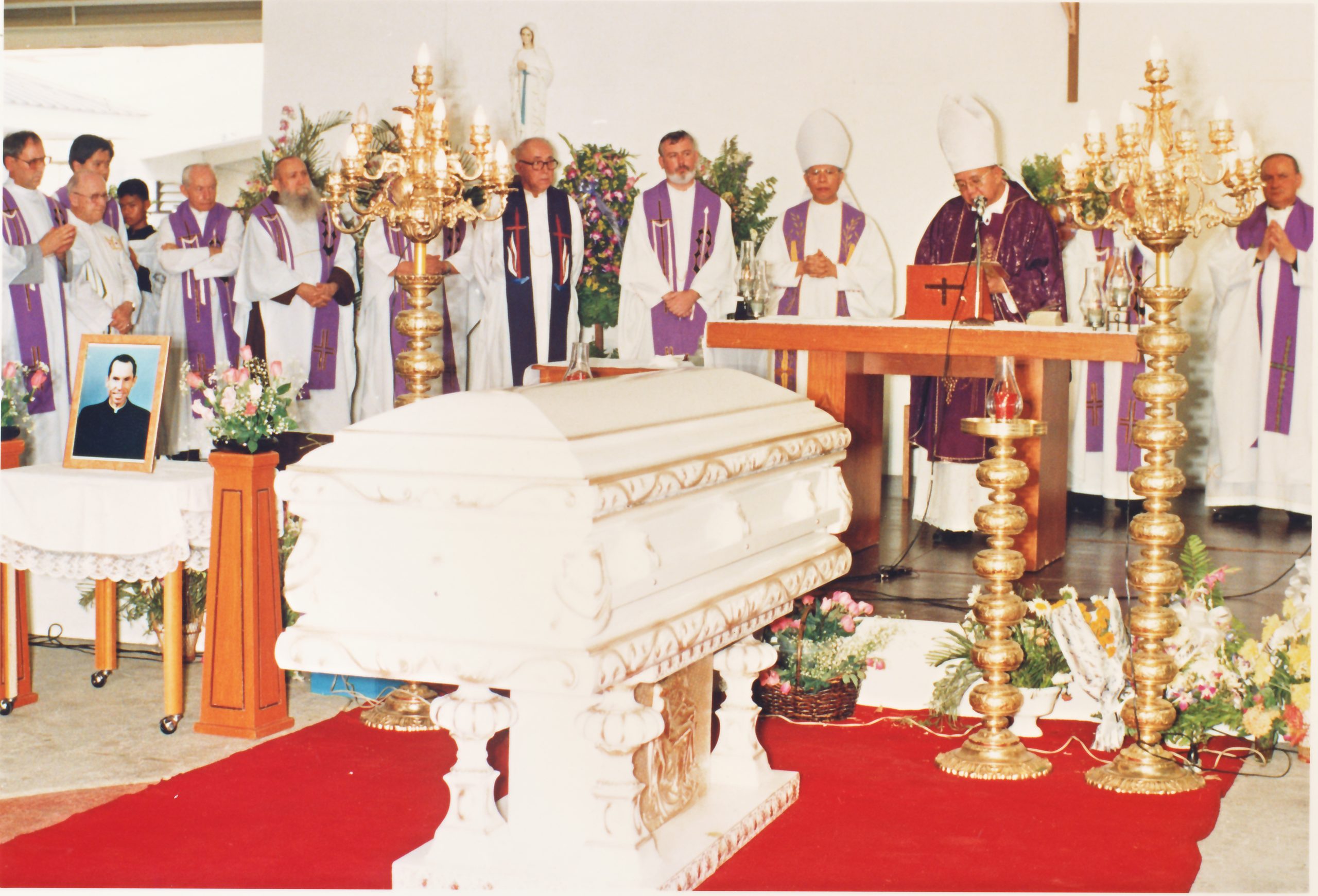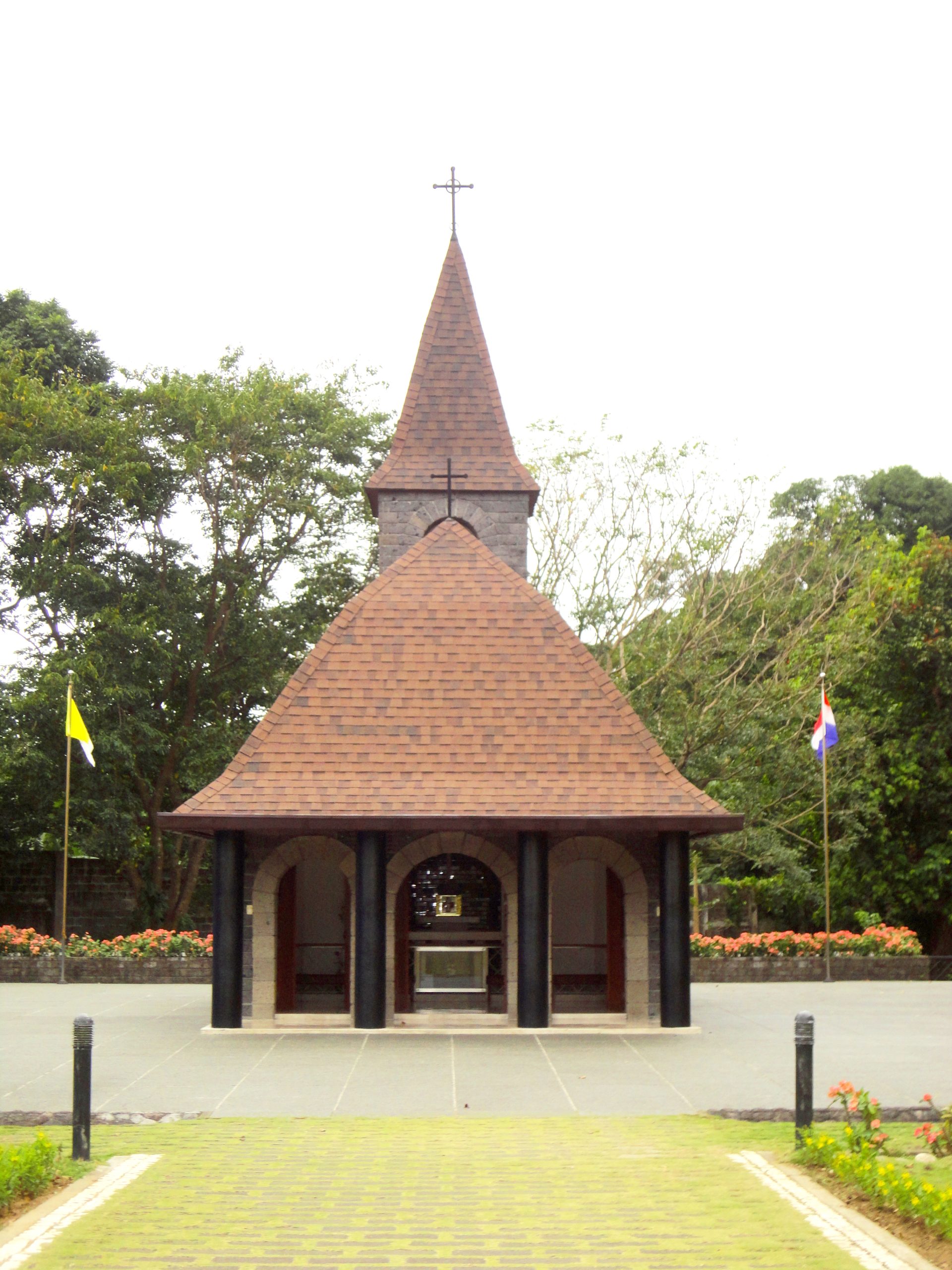Who is Father Al
Venerable Aloysius Schwartz, known to most people simply as “Father Al” proved that spiritual maxim with his own life.Books Authored
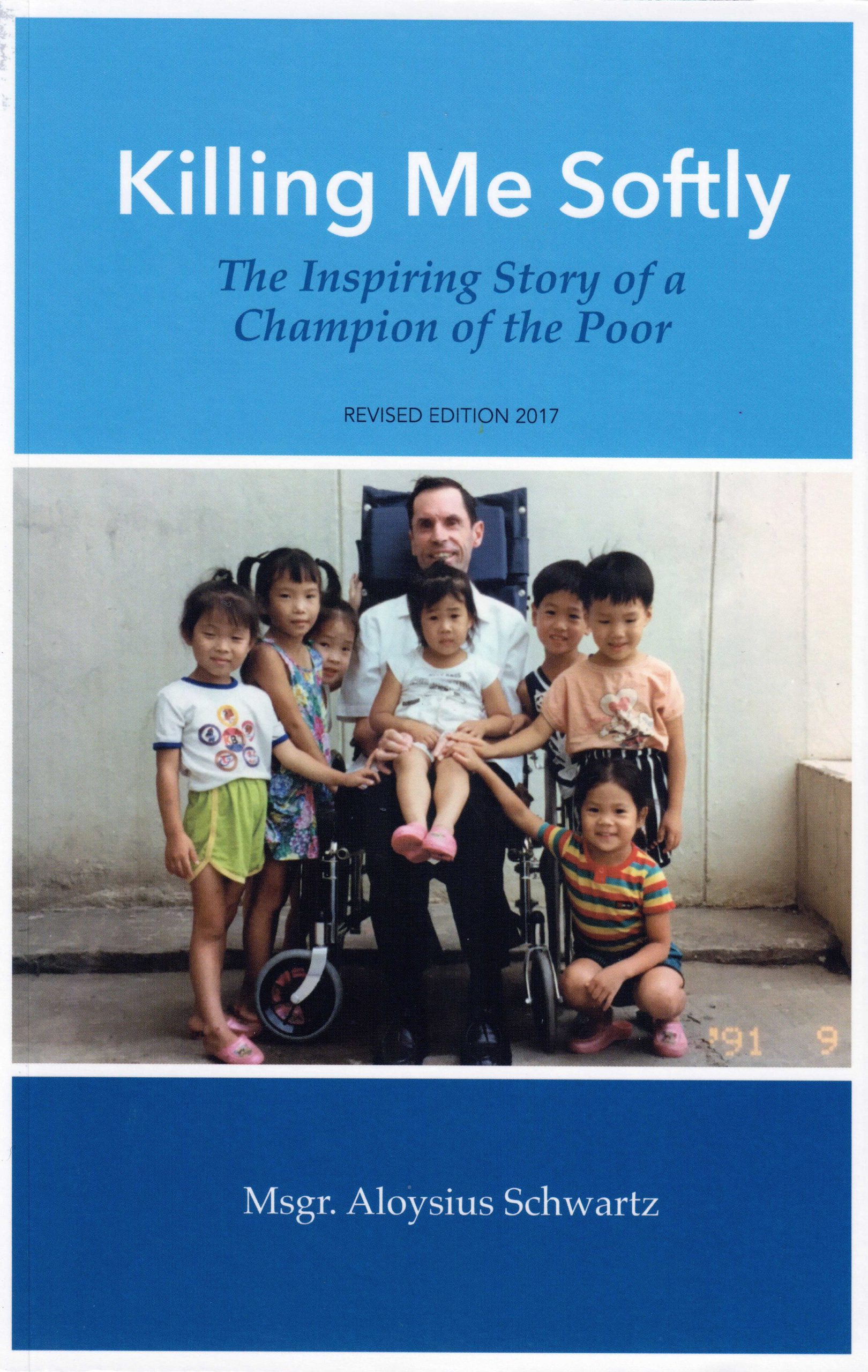
1993. Killing Me Softly: The Inspiring Story of a Champion of the Poor
Aloysius Schwartz. Alba House, Society of St. Paul.
This autobiographical account of the last years in the life of the internationally acclaimed founder of several Boystowns and Girlstowns – in Korea, the Philippines, and Mexico – is as moving as it is inspiring. In it the author recounts his ongoing battle with Lou Gehrig’s Disease (ALS) while trying to maintain and staff his growing number of homes for orphaned youngsters, a residential village for destitute, homeless, and handicapped men, two full service hospitals, a fledgling congregation of religious women, the Sisters of Mary and another of men, the Brothers of Christ.
1970. Poverty: Sign of Our Times
Aloysius Schwartz. Alba House, Society of St. Paul
Christ’s presence in the poor: that is the reality to which too many Christian eyes are dimmed. Yet all our talk of reform and renewal will come to naught unless the Church – and we are the Church – faces the challenge of poverty. Today the Church is, in the eyes of most of the world, almost a middle class phenomenon, the Comfortable Church. This disturbing book should shake our complacency. There is urgency and holy anger in its pages. But time is running out, and there is need for the anger and anguish of concern. The work raises questions in stark perspective and tells us that unless the Church becomes the Church of the Poor, it cannot hope to speak to modern man.
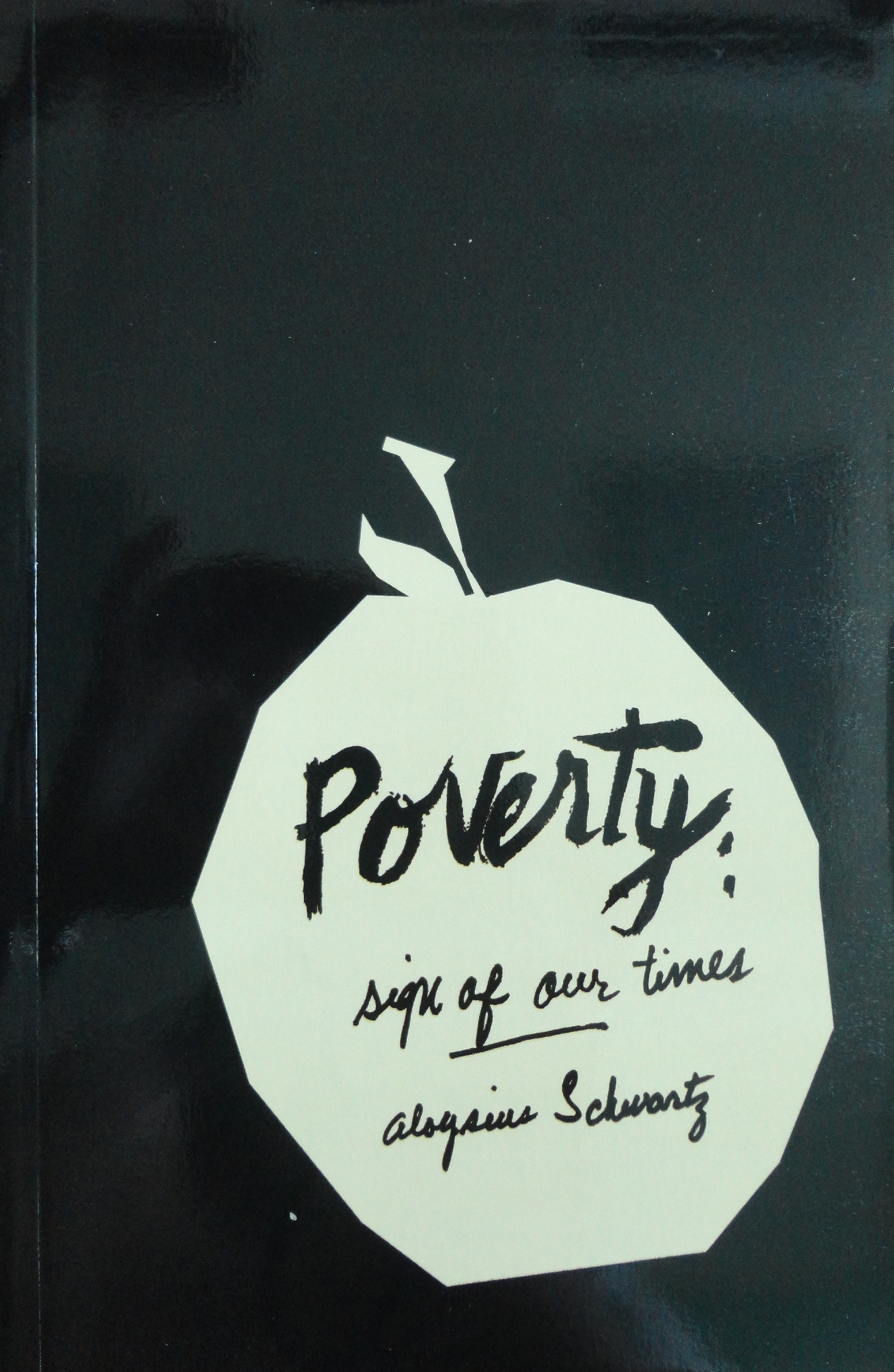
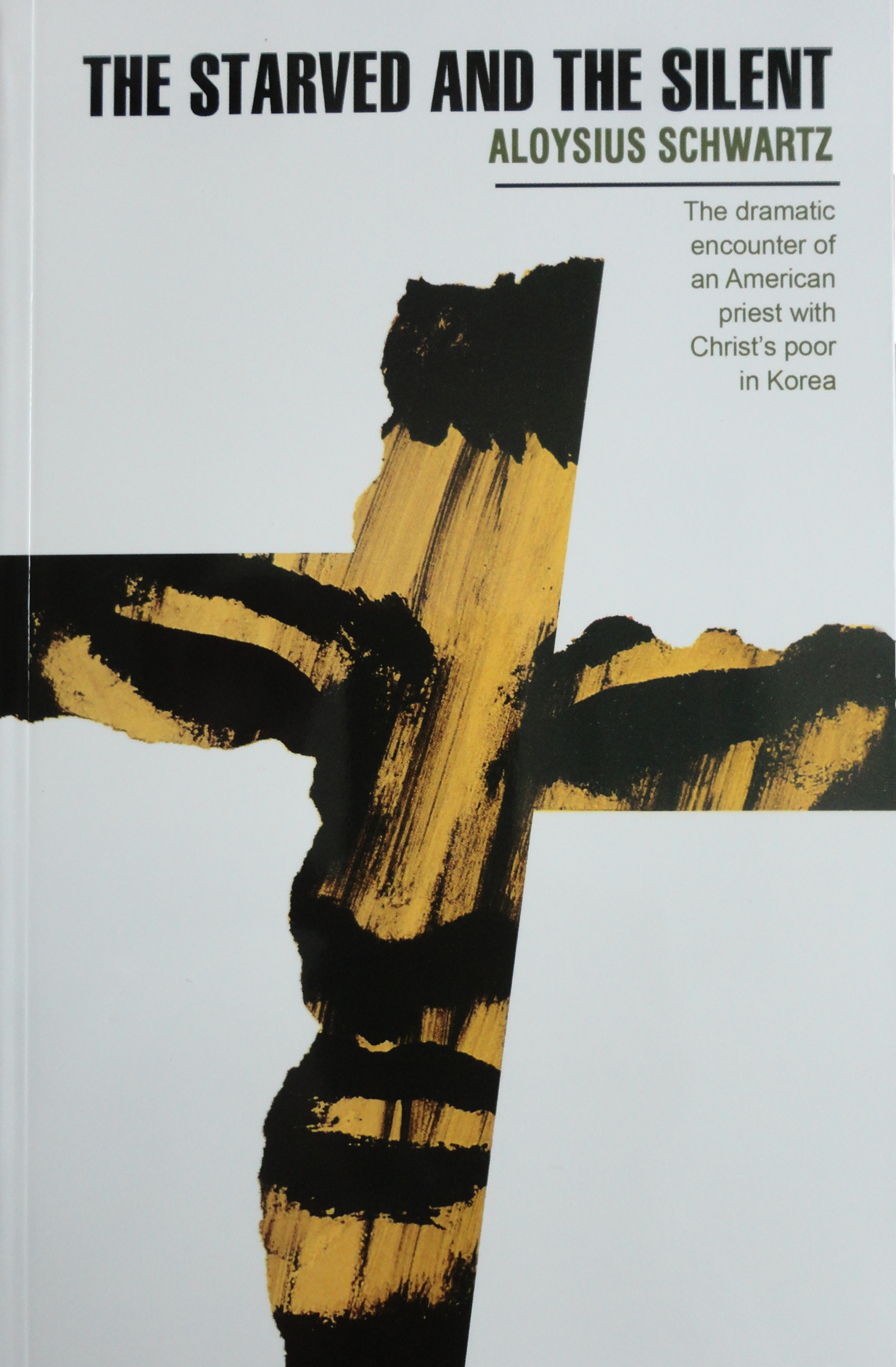
1967. The Starved and the Silent: The Dramatic Encounter of an American Priest With Christ’s Poor in Korea
Aloysius Schwartz. Doubleday & Co., Inc.
Although this book is autobiographical in form, the story of the author’s life is only the backdrop against which is played out the drama of “the starved and the silent” people of Korea – a drama of privation so complete and despair so intense as to be almost beyond the imagination of a member of “the affluent society.” Father Schwartz explains first the circumstances which led him to become a parish priest in Busan, Korea, rather than a missionary; then he describes his parish activities as pastor, economist, social worker, and psychologist among a people incredibly different from us in their way of life, their needs, and their goals.
1991. To Live Is Christ
The Sisters of Mary Book of Spirituality
Aloysius Schwartz. Government Institutes, Inc. Rockville MD 20850 U.S.A.
In the book, Msgr. Schwartz laid down carefully the manner in which he perceived that the Sisters of Mary, his spiritual daughters should fulfill their vows. The book which is to be studied during the novitiate of the religious of the Sisters of Mary first explained that the novitiate of the Sisters of Mary is a working novitiate as based from Christ’s novitiate which was action oriented (Christ and His apostles).
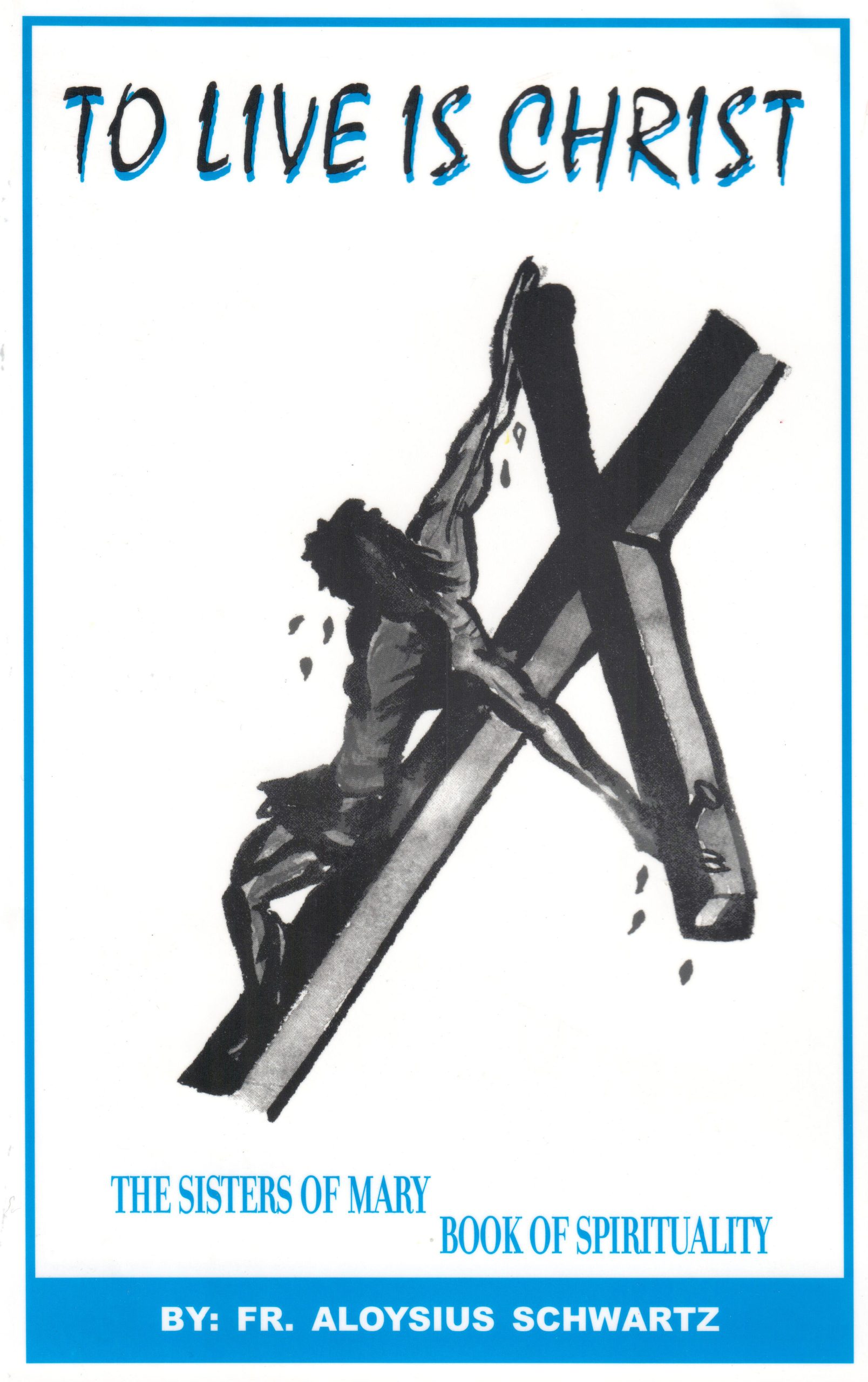
Get a copy of Father Al’s books by contacting www.worldvillages.org
LIVING IN THE SHACK
A miniature representation of the of Father Al’s shack on exhibit at the Father Al’s Museum in the Philippines
Father Al moved into his shack in 1961 to give the Benedictine Sisters a place to stay in the parish rectory.
Fr. Al stayed in this shack until 1965, when he left the Parish of Song-do in Busan and moved to another location, where he set up the headquarters of the “Mariahwe” Sisters and his Child Welfare Program.
Father Al recalled
While living in the shack, I wrote my first book, “The Starved and the Silent,” concerning the poor in Korea and the poverty of Christ. Also, I founded the Sisters of Mary and started my apostolate to the poor. This shack-living certainly was not essential to these programs, but I felt it was quite helpful.”
“All in all, I consider my years in the poorhouse as one of light and grace. And I look back upon this period of time with gratitude and nostalgia.”
Here is Father Al’s firsthand account of his years in his poorhouse.
You may ask what helped me relate to the poor. As I mentioned previously, I was named pastor of Song-do Parish in Pusan. In the spring of that year, I moved out of the Bishop’s house where I was staying to take up my duties as a parish priest.
At first I lived in a small Korean cottage, which was part of the parish plant. After considerable effort and using the good offices of Bishop Choi, I prevailed upon some Korean Benedictine Sisters to come live and work in the parish. Korean Sisters are a great asset to any parish in Korea. They conduct catechetical classes, work with the children, do home visitations, help with the liturgy, and assist the Pastor in many other ways. Their presence heightens the spiritual tone of the parish and very often means the difference between a parish which is alive and dynamic and one which is dying.
I was delighted that three Sisters were coming, but there was one problem. There was no place for them to live. I could have built a convent on a small piece of ground adjacent to the Church, but this would take time. Since the demand for Sisters at that time was very great and the supply was very short, I felt that any delay in establishing the presence of the Sisters in the parish might result in losing them.
At that time there was a Korean squatter family living in a shack which they had built on church property. The shack was a non-descriptive hovel with a tarpaper roof and mud walls, similar to what other people in the parish were living in. I offered this squatter family a sum of money to purchase or rent shelter elsewhere, and prevailed upon them to move out.
My idea was to fix up the shanty in which they were living and use it as a temporary rectory. After the premises were vacated, I went to inspect my future dwelling with my parish assistant, Damiano. The place looked very uninviting and I wasn’t sure whether it was livable or not. I turned to Damiano and asked what he thought. His reply was simply, “Sure, Father, with determination you can do it.” That simple remark was decisive and I decided, under the circumstances, to give it a try.
When people in the parish got wind of what I was going to do, they reacted with horror...
The fact that the shack differed very little from the houses in which many of them were dwelling seemed to make no difference. They uttered dire predictions, which had a somewhat unsettling effect on me.
They predicted that if I didn’t die of tuberculosis, I would be eaten alive by the rats and bugs, and if sickness and rodents didn’t do me in, then robbers, who would assault the place at night and smash my head, would finish the job.
Frankly, what worried me more than the tuberculosis, rats and armed robbers was the simple fear of making a fool of myself. But the words of my faithful servant, Damiano, “With determination, you can do it” urged me on. Of course, what I might term “determination” another would call “bullheadedness,” but that’s another matter.
I fixed up the shack as best I could and move in. It worked, but just barely. I encountered a number of difficulties. First was the smell, a rich, earthy, overpowering smell, composed of human excrement, dead animals, garbage, bugs and dirt. At first, the smell was so awful I had trouble sleeping at night.
But I kept shifting my sleeping bag about the house until I eventually found a corner where the air was somewhat breathable. Then I made a determined assault to extricate the cause of the odor. I discovered one or two dead rodents in the walls, and using some chemicals eventually changed the odorous aspect of the parish house. Also, I am sure that unconsciously my sensitive American nose became desensitized with time, and although the smell lingered on, my reaction to it diminished.
The smell from the dead rats was one problem. The noise at night from the live rats which scurried about in the space between the roof and the ceiling was another problem. Rats are real swingers, and every night when I lay down to sleep, they would come alive and start a disco dance just over my head. Before crawling into my bed at night, I would position a broom alongside me.
When the rats got too exuberant, I would hit the ceiling with a broom. This would startle them into immobility for a period of time. I waged constant warfare with the rats and although at times I seemed to be winning, I guess the final result would best be termed a “stand-off.”
Another problem was the cold.
During winter months cold, icy wind would find its way through many cracks, holes and crevices and at times, heating the place properly became something of a problem. The shack was heated by yonthen coal, as are most homes in Korea.
Yonthen coal briquettes are made of compressed coal dust and clay. They heat the floor from below and this works pretty good except they give off a deadly, odorless carbon monoxide gas which every year claims many lives in Korea. While living in my “poorhouse,” on two or three occasions when the floor cracked, or at night when the air was laden and heavy and prevented the smoke from exiting property, the cottage became filled with yonthen fumes.
Several times, I remember stumbling out the front door semi-conscious and reeling as a drunkard leaving a tavern at night. After a while, I considered the yonthen too dangerous and eventually installed a small diesel-burning space heater. One night I woke up to find my shack on fire as a result of the diesel fuel leaking, but the fire was quickly put out and there was very little damage.
A final problem, which is in a category by itself, was the problem of the outhouse. The outhouse was located about 20 feet from the front door. I grew rather fond of it over the years. It was a little smaller than a telephone booth and consisted of a leaky roof, four walls made out of planks, and, of course, the strategic hole in the middle of a shaky wooden floor. I have a clear recollection of days when a trip to the outhouse required uncommon courage.
It was the rainy season, the wind was blowing, the rain was coming down in sheets, it was cold. An umbrella was useless because of the strong wind, so I would simply fling open the front door, dash 25 feet across the muddy yard, shoot into the outhouse, and position myself. So far, so good.
Then as the rain was leaking on my head and I was wondering whether the planks would resist the wind, I glanced down at the spot where a roll of toilet paper should have been. It was gone. The mysterious “toilet-paper-snatcher” had struck again. This was the final blow.
I could take the rats and the cold and the deadly gas, but this was something else. It happened repeatedly, and the culprit would leave nary a clue. My toilet paper was not such a luxury, but simply something sold on the Korean market for about 10 cents or so. I didn’t like the dirty, inky Korean newspaper which most people in Korea used, so I indulged in genuine toilet paper. But someone, I never found out who, always slipped into my outhouse and absconded with it.
Such were the perils of trying to live with the poor life in Korea. But poor style living had its positive elements as well.
One’s surroundings definitely conditions one’s thinking.
By living more or less poor, I discovered it was easier to think poor, to feel poor, and to stay on the same wave length as the poor.
I lived in this parish shack for nearly five years from 1961 to 1965, when I left the parish with the Sisters and the children to move to another location where I set up the headquarters for both the Mariahwe Sisters and our child welfare program.
While living in the shack I wrote my first book, The Starved and the Silent, concerning the poor in Korea and the poverty of Christ. Also, I founded the Sisters of Mary and started my social apostolate to the poor. This shack living certainly was not essential to these programs, but I feel it was quite helpful.
My shack also served as something of a protection. More and more funds were coming into Korean Relief in Washington. Word was getting around that I had control of large sums of money for welfare work. Many people began calling on me with various schemes and projects, all requiring capital. Some of these people were bishops and priests and religious.
Many of the schemes were half-baked, others were outright phony. Anyhow, I discovered that the office, in my shack, was the perfect place to discuss, and more frequently than not, turn down useless requests for relief funds. Many of the people requesting funds lost their initial enthusiasm when they saw my simple living quarters.
Also, my little shack protected my own reputation. At that time there was a great deal of hanky-panky in relief goods and relief funds in Korea. After a while no one trusted anyone who had at his disposal considerable amounts of relief goods or relief funds in Korea.
Since the funds at my disposal were gaining in importance, I automatically would be subject to suspicion and possible accusation of misuse and skimming for my own benefit. But when people saw my living style, any suspicion automatically dissolved.
Also, many of the Christians in my parish were “kujae pum Christians,” or “relief goods Christians.” Many of them entered the Church to get free grants of cornmeal, flour, milk powder and used clothing. Many of them still approach the church with a bad “gimmie” complex. So when they discovered that their pastor had control of large relief funds, many of them considered that they had a God-given right to a share.
But because of my lifestyle I was in a strong position to refuse useless requests, and I began a campaign of spiritual brainwashing. If I were living in more luxurious surroundings, it would have been very difficult to do this as effectively.
Of course, shack living has its negative aspects also. As mentioned before, many of the parishioners had their pride hurt. But after a while they came to accept the fact that their pastor was something of a nut and they laughingly let it go at that. Some of the other priests were not quite so accepting. My lifestyle was a silent reproach to them and they found this difficult to accept. “Why don’t you live like everybody else?” was a frequent question they threw at me. “What are you going to prove?” “Why don’t you live in a place where you can adequately work and function as a pastor?”
Some priest called my house “the monkey cage.” I have no intention of giving a lesson to anybody and I was somewhat embarrassed by these questions. However, I thought the positive aspects outweighed the negative ones, and so I opted to continue. I moved out in 1965.
All in all, I consider my years in the “poorhouse” as one of light and grace. And I look back upon this period of time with gratitude and nostalgia.
Al Schwartz and ALS
“God gives me suffering and pain, yet at the same time he puts into the depths of my heart a new secret joy, a spiritual pleasure and a supernatural peace which surpasses all understanding.”
~ Al Schwartz, Killing Me Softly
In his book, Killing Me Softly, Father Al vividly describes his battle with ALS in the last three years of his life, which he considered as the sum total of the 57 years or so which preceded them. Strange as one may see it, but he considered his sickness as a gift from God.
“Killing Me Softly―these words aptly describe the disease with which I am now afflicted. It is called amyotrophic lateral sclerosis (ALS) – more popularly “Lou Gehrig’s disease”. It is a terminal illness which kills but ever so slowly, ever so cruelly, ever so softly.”
THE DIAGNOSIS
In October of 1989, as his muscles continue to deteriorate, he consulted various well-known doctors in the United States, who gave him their services free of charge. After a series of tests, the result was that he had a fifty-percent chance to have contracted what is called Amyotrophic Lateral Sclerosis. Upon hearing this, he asked, “Is this disease life threatening?” The doctor told him the usual period of time was three years.
HIS DISEASE WITH HIS NAME ON IT
Father Al recounts: “I was in the car with Bill Vita (Bill Vita is his brother-in-law and in-charge of his fundraising operations at that time). I said, “Can you believe it? This disease ALS has my name on it.” Frequently, I would sign my name ALS. in place of Al Schwartz. Apparently, we two — that is, amyotrophic lateral sclerosis (ALS) and yours truly, ALS — were destined for each other.”
HIS BATTLE WITH ALS
ALS brought him many sleepless nights, as sleep disorder is one of the frequent problems of ALS patients. He would wake up in wee hours after a mediocre sleep not from tossing and turning all night because tossing and turning are luxuries which are denied the ALS patients, but from pain in his arms, legs and all over his body.
He would also suffer bad falls trying to help himself stand.
As the disease is described as “terminal” and “very cruel and demeaning”, he writes, “Right now, I have very little control over my environment. I have lost all independence and so-called dignity. However, I do not find this all that devastating. I think of Jesus, Lord and Master, who had all power in heaven and earth, yet He deigned to become a small infant. He entrusted Himself totally to the Virgin of Nazareth.” Father Al became totally dependent on the help of others and so he considered the Sisters who were taking care of him as his angels of mercy.
In officiating Mass, flies landing on his nose or his forehead added to his agony. Also at Mass, he had to struggle to keep his head erect to avoid having it fall down on his chest. If so, a Sister would come to lift it back again.
He also became extremely sensitive to cold and heat. But, what struck Father Al the most in his sickness is that it kept him from running, the only secular diversion that he loved.
THE FINAL STAGES … THOUGHTS ON LIFE-SUPPORT SYSTEM
As the disease progressed, his health deteriorated and declined. He writes about his thoughts on life-support system.
“[…] normally, an ALS patient, in the final stages of illness can no longer speak. However, the eye muscles are never affected by the disease. In the last five or ten years, technicians have developed sophisticated computers with voice synthesizers which can be activated by simply winking and blinking your eyes. The good news is that, even if you are on life-support systems, breathing through a tube in your throat and eating through a tube in your stomach, you can still communicate with the outside world. I personally feel a certain revulsion at the thought of being hooked up to these life-support systems. The idea of lying there, totally paralyzed, breathing through a hole in your throat, eating through a tube in your stomach and speaking through a computer by winking and blinking your eyes, holds little appeal for me. My gut instinct at this point in time, although it is quite possible that later I may change my mind, is to let nature take its course and to accept death without trying to outwit it by any extraordinary means.
Some ALS patients who are on life-support systems are held up as heroes. They are spoken about as models of courage, determination and as having the will to live. This is one point of view.
An equally strong case can be made for the opposite. It can be argued that it is just as courageous, heroic and noble to accept death with calm, dignity and serenity as it is to accept a prolonged illness and disability with the same calm, dignity and serenity.
With the help of the grown up boys at Boystown, Father Al still went around to check-up on his children or celebrate Mass for them at the chapel.
Father Al shared in the pains and sorrows of the homeless elderly and disabled men at the Village of Peace which he founded in 1981. When he contracted ALS, he truly became one with them in everything.
A Mexican child shows his gratitude to Father Al during the inauguration of the Boystown and Girlstown in Mexico in 1991
However, those closest to me, namely, the Sisters of Mary, all seem to feel rather strongly that I should hang on to life as long as possible, even though I am hanging only by my fingernails. They even make me feel, at times, that to choose a different course could somehow be interpreted as being a coward.
The heart of the issue, however, is not what I want nor what the sisters want nor, for that matter, what anyone else wants. The real question is: what does the Lord want? In this spirit, St. Paul writes, ‘Whether I live, I live for the Lord, whether I die, I die for the Lord. Whether I live, whether I die, I am the Lord’s.’”
On his wheelchair, Father Al continued to perform his obligations as a priest and a spiritual father to the Sisters and Children.
HIS BODY RESTS. HIS SPIRIT LIVES ON
Father Al solemnly passed away at 7:00 pm, Monday, March 16, 1992, in his room on the 7th Floor of the Manila Girlstown building surrounded by some Sisters of Mary, while all the children at his Boystowns and Girlstowns in the Philippines are praying the Holy Rosary.
His remains are buried under the altar of the Chapel of the Virgin of the Poor in Silang Girlstown complex.
Upon his instruction, the words written on the plaque placed on the tomb read as follows: “Here lies Father Al Schwartz. All praise honor and glory and thanksgiving to the Virgin of the Poor.”
If I leave this world, I will not leave the work and the sisters and the children and the brothers. As St. Therese of Lisieux says, “I will come back and continue to do good until the end of the world.” Being a hyperactive, restless type, if I go to heaven I will come back and spend my eternity in aiding the sisters and the children in a hidden, secret but very real manner.
~ Al Schwartz, Killing me Softly
Father Al passed away almost in the same way that he had always pursued his ministry—simply, quietly, even solemnly.
For years, people have been asking me the questions...
“What happens when you die? What happens when you are no longer around? Who will succeed you? Who will continue your work?”
Nothing will change essentially after I am gone. In a sense, it will be business as usual. What do I mean by this? The real Director and Chairman of the Board of the Sisters of Mary is Mary, Our Lady of Banneux, the Virgin of the Poor…
Mary will continue to be with the sisters. She will guide, direct, rule, supervise, help them, bless and fructify their work.”
~ Al Schwartz, Killing Me Softly
On March 25, 1992.
More than 5,000 supporters came to bid him farewell.Joining His Eminence Jaime Cardinal Sin (Archbishop of Manila), Bishop Teodoro Buhain (Auxiliary Bishop of Manila), Bishop Jose Maria Hernandez (Bishop of Nezahualcoyotl, Mexico) and twenty five other priests were religious brothers and sisters, children and graduates of Boystown and Girlstown, his siblings, and friends from the Philippines, Korea and other countries.
As per Father Al’s instructions before he died, the chapel, which is a replica of the Chapel of the Virgin of the Poor in Banneux, Belgium, was constructed, and his remains were placed under the altar of the chapel.
Father Al has gone to receive his reward, but not to rest, since he promised he would be working hard for his children on earth, with which he is doing every day.
Father Al’s spirit lives on with the Sisters of Mary and the Brothers of Christ as the mission and charity programs he started continued to grow after his demise to Guadalajara (Mexico), Guatemala, Brazil, Honduras, and Tanzania.
Pilgrims come to visit the replica of the Belgian Chapel of Apparitions in Cavite, Philippines where Father Al’s mortal remains lie.
Father Al has gone to receive his reward.
but not to rest, since he promised he would be working hard for his children on earth, with which he is doing every day.
Father Al’s spirit lives on with the Sisters of Mary and the Brothers of Christ as the mission and charity programs he started continued to grow after his demise to Guadalajara (Mexico), Guatemala, Brazil, Honduras, and Tanzania.
May his shining example stir in the heart of everyone the earnest love for God by seeing, touching, and serving Him in the person of the poor.
“For me, to live is Christ and to die is gain…”
Phil 1:21
FATHER AL’S MODELS OF HOLINESS
“A saint is one who resembles Jesus Christ in all things. He thinks as Christ, decides as Christ, judges as Christ, speaks as Christ, acts and does as Christ. By following Jesus each day, by imitating Him, by resembling Him, we become Saints.”
Al Schwartz
Homily, Manila, Philippines, 1989
“I first made acquaintance of Saint Thérèse at the age of sixteen when I was in the Minor Seminary. She captivated my heart and has been a very special friend all my life. She is my model of perfect patience and gentleness.”
Al Schwartz
Killing Me Softly
“In this world we work, and in the next, we rest…”
St. John Vianney (1786-1859)
These famous words of the Patron of Priests have inspired Father Al to fully live his ministry until the end of his life.
“The poor are my masters…”
St. Vincent de Paul (1581-1660)
Father Al would take from St. Vincent de Paul his selfless dedication to the poor.
“Let nothing disturb you…nothing frighten you…everything passes, only God doesn’t change. He who has God, nothing is lacking!”
St. Teresa of Avila
(1515-1582)
From her, Father Al learned to fully trust in God and to have the courage to do all things in union with God.
“If we possess property, then we shall need arms to defend it and in the end it will turn us away from the love of God and neighbor.”
St. Francis of Assisi
(1182-1226)
Inspired by the poverty of Saint Francis, Father Al lived poor himself in order to serve the poor in the name of Christ.
“Give me souls and take away all the rest…”
St. John Bosco
(1815-1888)
Taking from St. John Bosco that zeal
for the salvation of souls, Father Al would ask for his intercession.
World Villages for Children
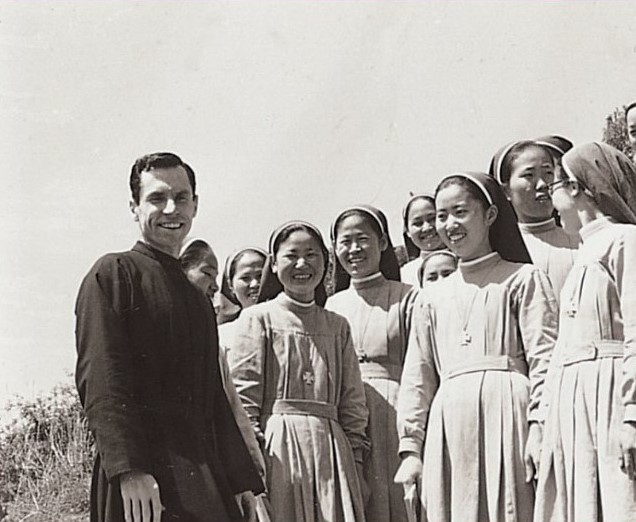

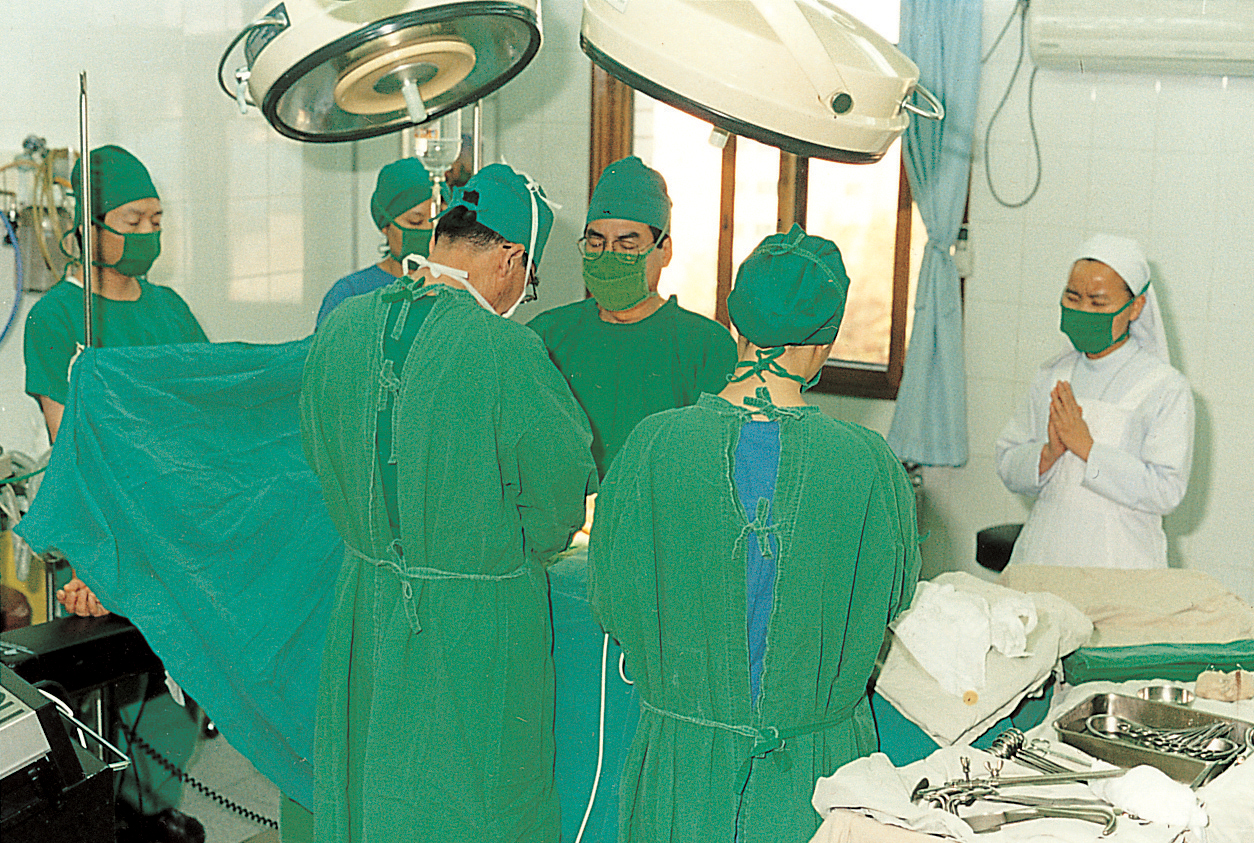
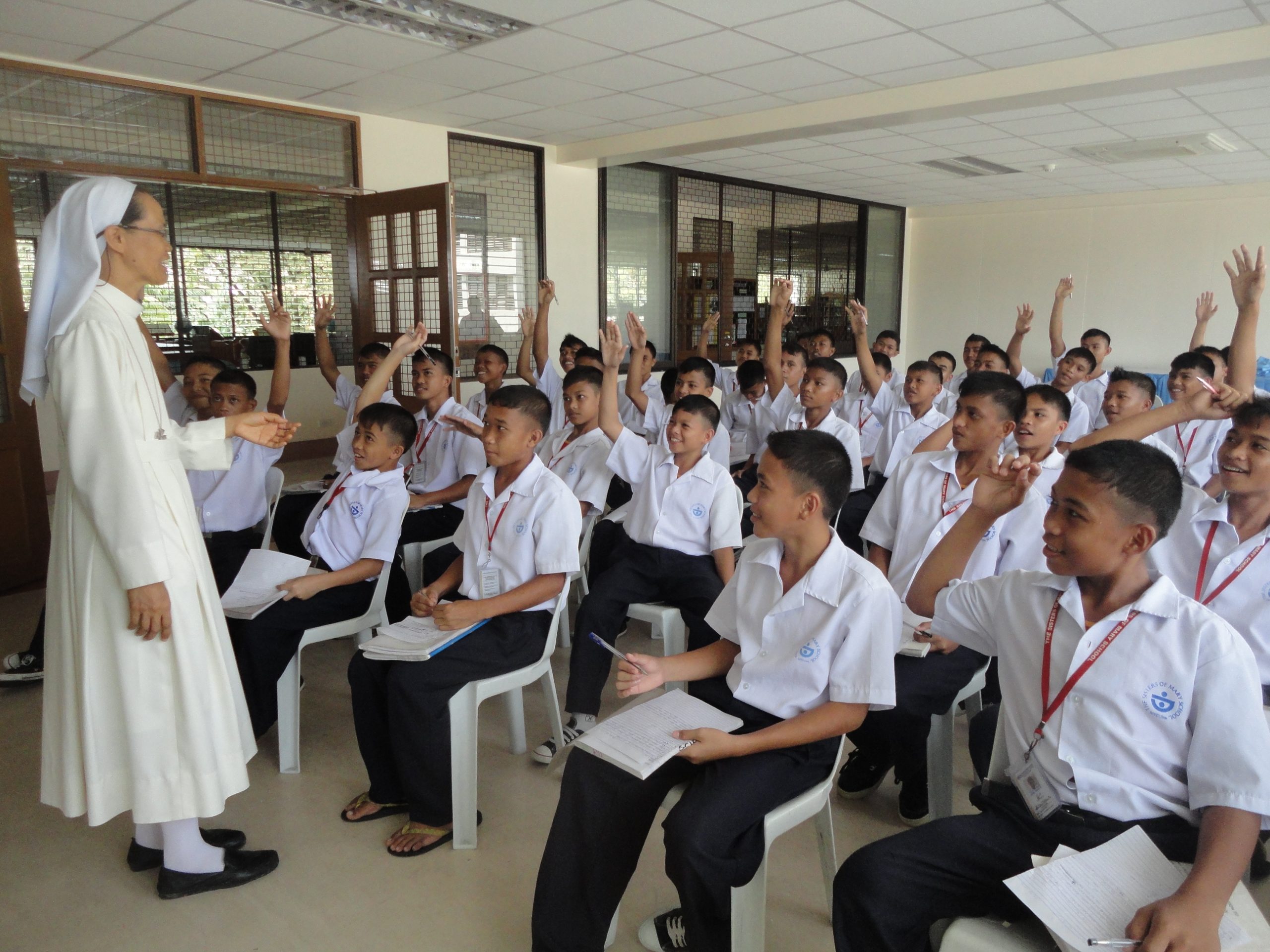
HIS VISION CONTINUES
Today, throughout our world – from Central and South America to parts of Asia – children born into poverty are being given an opportunity to lead a better life.
They’re part of a loving family in Christ … one that’s devoted to providing them with food, shelter, clothing, medical care, and an education…
… just as it’s been given to the thousands of other children who’ve come before them.
This is happening because of World Villages for Children — founded in 1964 by Monsignor Aloysius Schwartz – more affectionately called “Father Al” by those whose lives he touched. His was a life of unconditional love …
THE ROAD TO SAINTHOOD…
"A saint is a person so grasped by a religious vision that it becomes central to his or her life in a way that radically changes the person and leads others to glimpse the value of that vision"Lawrence S. Cunningham,
The Meaning of Saints (San Francisco, CA: Harper & Row, 1980), 65.
How Does the Catholic Church Declare Saints?
According to the provisions of the apostolic constitution Divinus perfectionis magister and its Normae (promulgated on 25 January and 07 February 1983 respectively), a beatification cause may be initiated by a petitioner five years after the death in fama sanctitatis (with reputation for holiness) or in odium fidei, uti fertur (presumably killed out of hatred for the faith) of one or a group of professed Catholics. This petitioner, or actor, may be an individual or, as commonly practiced, a group (e.g., a parish, a religious congregation, a diocese, an association of lay faithful, or even a civil body) duly recognized by ecclesiastical authorities whose task is to finance and promote this enterprise. However, the pope himself could waive the required five-year waiting period, as in the case of Mother Teresa of Calcutta and John Paul II.
The actor must name a postulator who must be duly recognized by the bishop of the diocese where the Servant/s of God died (canonically referred to as the competent bishop). A postulator is the lawyer of the cause and representative of the actor before the Congregation of the Causes of Saints (CCS), the Vatican office that has direct jurisdiction over such matters. He/she may also appoint a vice-postulator who acts in his/her behalf within the diocese . It is the task of the actor, through the postulator, to request the competent bishop to launch a formal diocesan inquest into his/her/their life. On the same time, the CCS designates a protocol number to refer to the case. In case the bishop of another diocese were to act, for a legitimate reason, as the competent bishop for the cause of someone who died outside the jurisdiction of his territory, he would have to obtain the decree competentia fori from the CCS.
Divinus perfectionis requires the competent bishop to consult with the bishops of his ecclesiastical region on the appropriateness of initiating the cause. He must also publicly publish the petition of the postulator and invite the faithful to report to him any information they may have on the Servant/s of God. Then, should he decide to officially initiate the cause, the competent bishop must assign two theologian-censors to examine both published and unpublished writings of the Servant/s of God . A favorable opinion from them is necessary to proceed with the cause. After this, he assigns a promoter of justice whose task is to draw up a questionnaire for witnesses based on everything that has been collected concerning the cause. Finally, the competent bishop must obtain from the CCS the decree nihil obstat, which would certify that nothing in the records of any Vatican office would merit a suspension of the investigation.
After obtaining the nihil obstat, the competent bishop or his delegate summons and examines witnesses before a diocesan tribunal. The witnesses include those brought in by the postulator as eyewitnesses to the life of the Servant/s of God as well as those who had examined his/her/their writings. They will be examined using primarily (but not exclusively) the questionnaire drawn by the promoter of justice. After this, the competent bishop must also ascertain that there is no public cult accorded to the Servant/s of God in his/her/their burial place or sleeping quarters. When the diocesan inquest is accomplished, two faithful copies of all its acts, the so-called transumptum, are sent to the CCS.
At this point, the CCS ascertains the decree on validity of the diocesan inquest. Having done this, the congregation appoints a relator to the cause. An official from the CCS, the relator’s task is to supervise the writing and publication of the positio by a collaborator (who may or may not be the postulator himself/herself). The positio has two essential parts:(1) the informatio, a critical biography of the Servant/s of God based on the transumptum; and (2) the summarium, a collation of the testimonies of the witnesses during the diocesan inquest and documents relative to the life of the Servant/s of God. It will be examined by three different bodies of experts – historians, theologians, and prelates – who work for the CCS and whose votes would determine the final outcome of the cause. When these three bodies unanimously give a favorable decision on the positio, the CCS draws up a decree on the heroic virtues or martyrdom of the Servant/s of God. Normally, this decree is formally read and promulgated before the pope in a public audience. From then on, the Servant/s of God begins to be referred to as Venerable.
In the case of martyrs, what follows is the designation of the date for the solemn beatification. For non-martyrs, however, another decree is needed. The Vatican requires that one exceptional miracle be proven to have been wrought through the venerable’s intercession. When this is found, the postulator and the bishop of the diocese where the miracle occurred must petition the CCS to authorize its investigation. All records gathered during this inquiry are to be sent to the CCS, which then appoints a body of qualified physicians or scientists, the consulta medica, to judge its extraordinariness. A favorable judgment from this body is presented to the theologians and prelates of the CCS. The pope who formalizes his recognition of the miracle through a decree. Only then can the non-martyr’s beatification be finally scheduled.
The beatification normally takes place in Rome. Pope John Paul II celebrated many of these rites in the country where the candidate for beatification lived, labored, or died. From 1971 to 2004, the pope himself has officiated this ceremony. Until then, a cardinal appointed by the pope presided over the rite. After the solemn act, the venerable is referred to as Blessed. However, his/her/their cult is canonically limited within a particular ecclesiastical jurisdiction or religious community.
For the blessed to be canonized, the actor of the cause must again find one more exceptional miracle that took place after the beatification. The very procedure for investigating a miracle before the beatification is to be repeated. When the decree over this miracle is promulgated, a special consistory consisting of the pope and cardinals is later called to determine the date of canonization itself. After this ceremony takes place, the blessed is henceforth to be called Saint and is presented to the entire church for veneration and emulation.
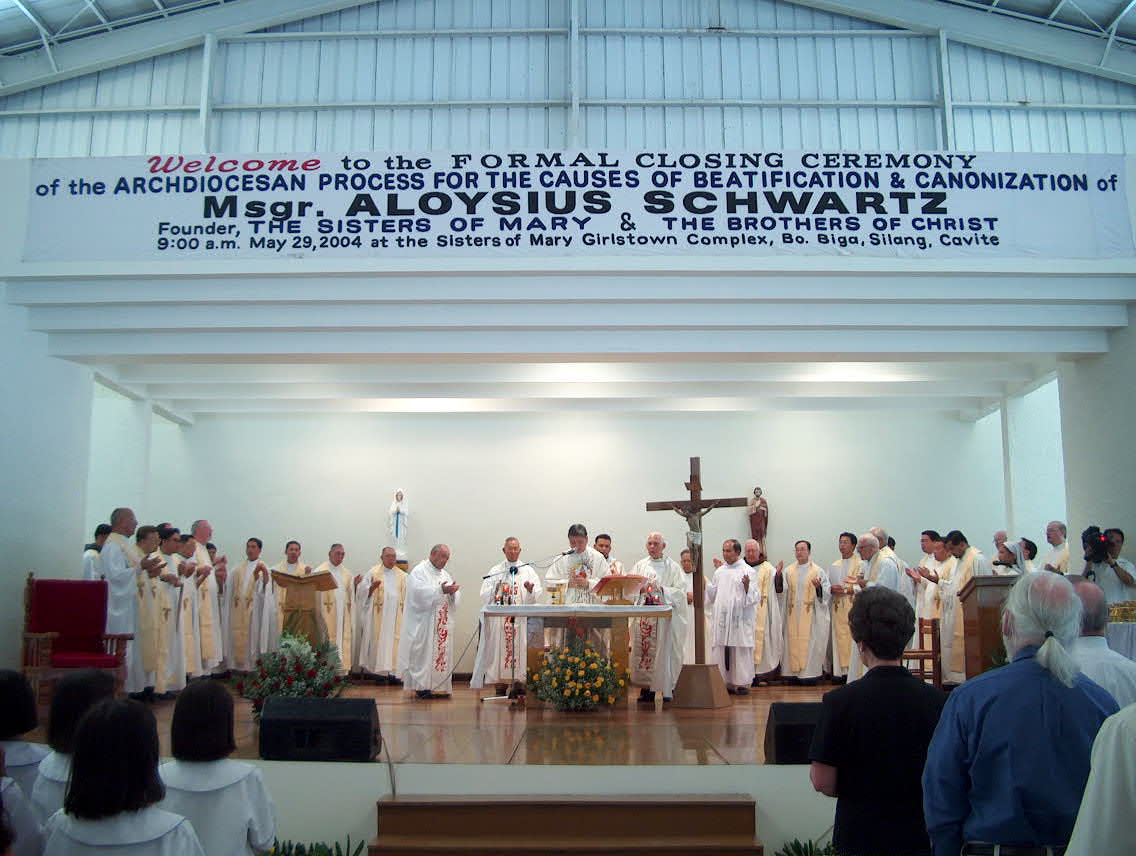
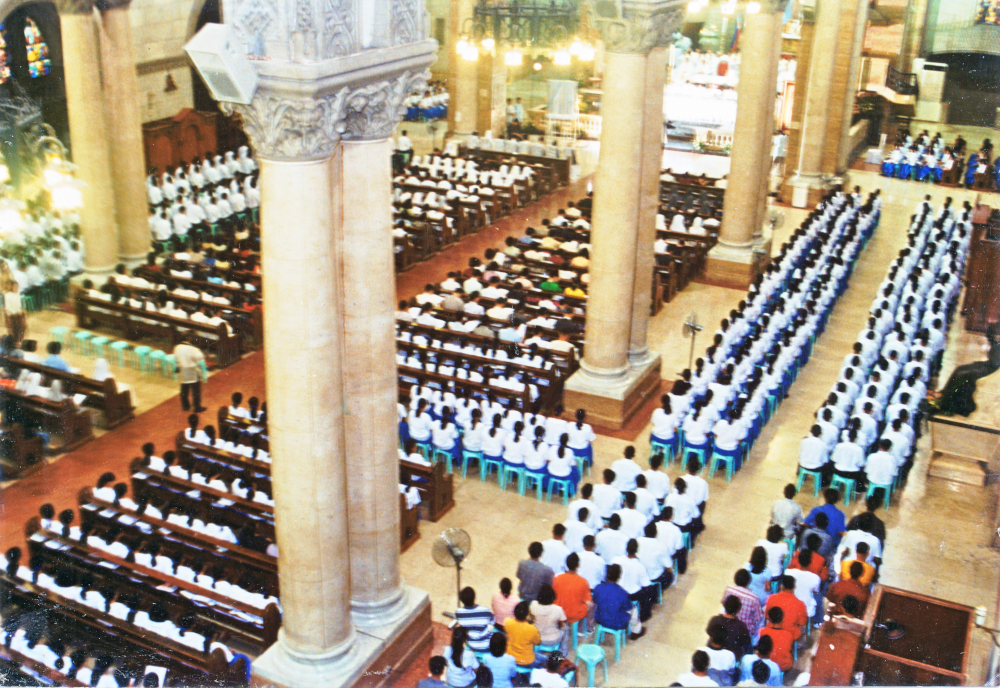
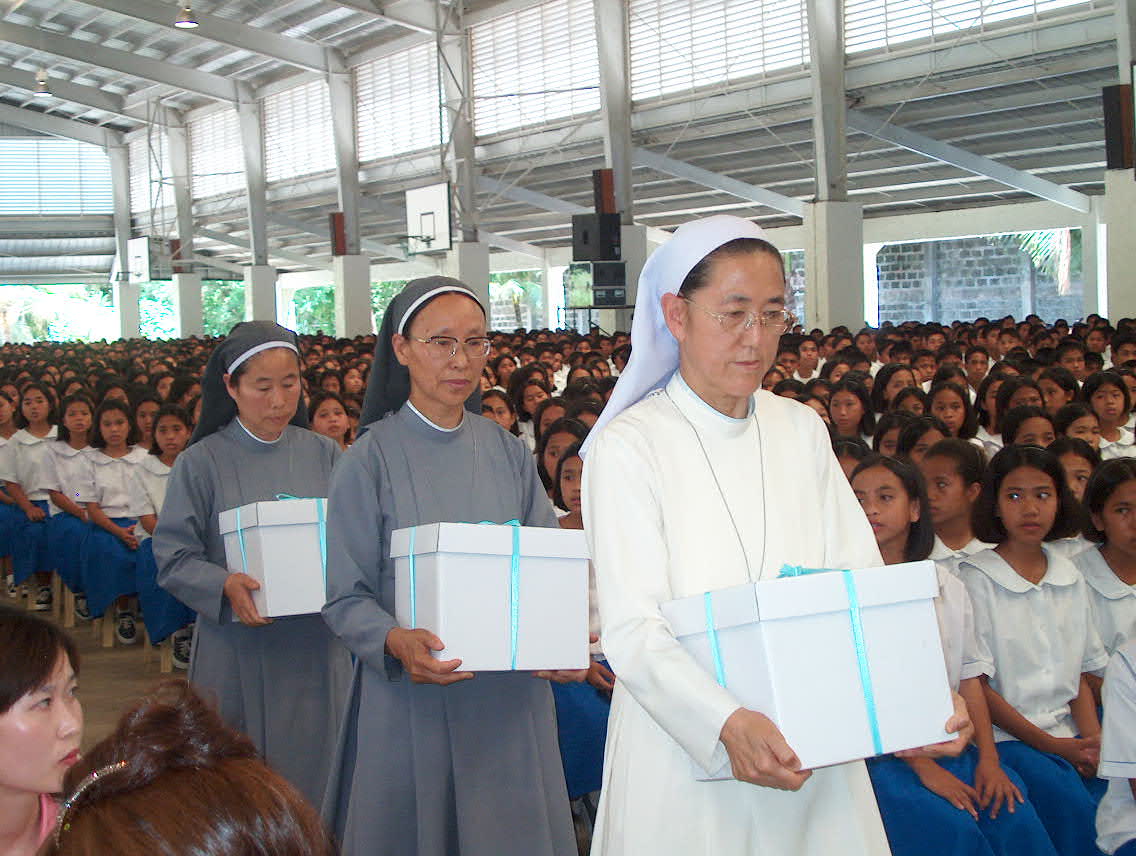
In an earnest effort to raise their priest, mentor, brother, friend and model of holiness – Fr. Al – to the altar as a saint of the Church, the long process for the cause of beatification and canonization was begun in the Archdiocese of Manila on December 10, 2003.
“Compassion, faith and common sense – these are the virtues which mark the greatest of modern saints. Compassion gave Msgr. Schwartz the sensitivity to see what people need. Compassion made him act to supply the need that he saw. Faith gave him the courage to pursue what he wanted to do. Finally, common sense brought his dreams to concretion. The combination of compassion, faith and common sense is rare in people. But when they do come together in generous measures, they combine to make a saint. ”Excerpt from the Homily of Ricardo Cardinal Vidal during the Opening of the Process for the Causes of Fr. Al’s Beatification December 10, 2003
The Positio about the Life, Virtues and Fame of Sanctity of Msgr. Aloysius Schwartz was presented to His Eminence Angelo Cardinal Amato, SDB, Prefect of the Congregation for the Causes of Saints on October 6, 2012 by His Eminence Luis Antonio Cardinal Tagle, Fr. Joseph Kijas, OFM Conv., Relator, Fr. Samson Silloriquez, OAR, Postulator together with Sr. Maria Cho, Sr. Michaela Kim, and Sr. Elena Belarmino of the Sisters of Mary.
“I will continue to pray for you. I will continue to offer, along with my prayer, through Jesus, for you and your intentions, my sacrifices and sufferings.”
Al Schwartz.
Excerpt from the homily delivered on the eve of his death Manila, Philippines, March 1, 1992
“As for me, life continues like a string of Chinese firecrackers. Something is always popping, always happening…
At times, my head spins and I grow a little dizzy, and long for a little rest and quiet.But the Lord is with me. His presence is very refreshing, reassuring, and renovating. It is he who accomplishes all that I do. Each day I try to run lightly, softly, and cheerfully along the way of the Lord and in the direction which he indicates.But, as you know so well, it is not easy. Each day has its measure of pain, struggle, effort, and humiliation… But each day also has a greater measure of joy, peace, and glory. So my heart is full of child-like gratitude and praise and amazement.”
Al SchwartzLetter to Sr. Gertrude, OCD, May 5, 1987
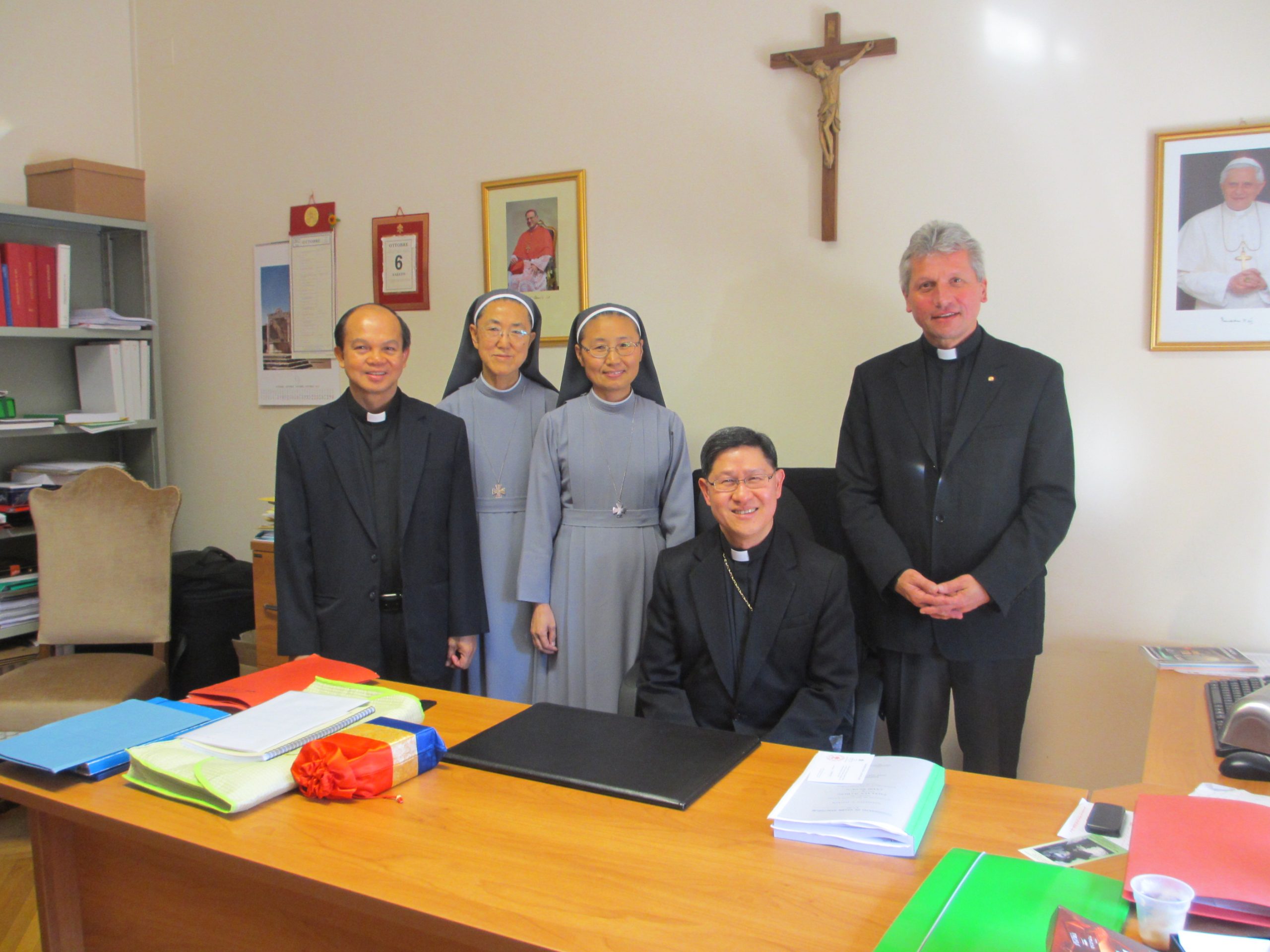
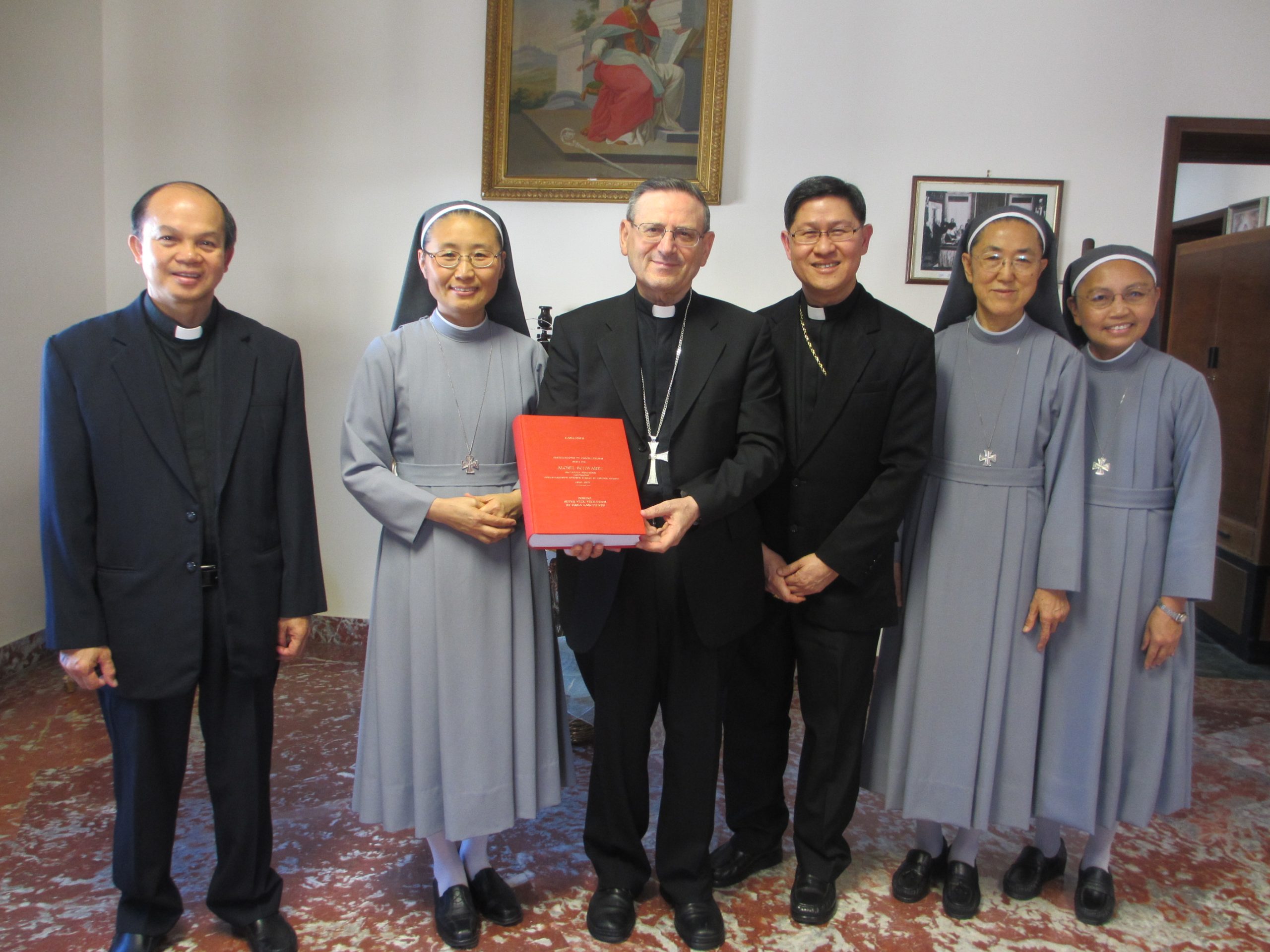
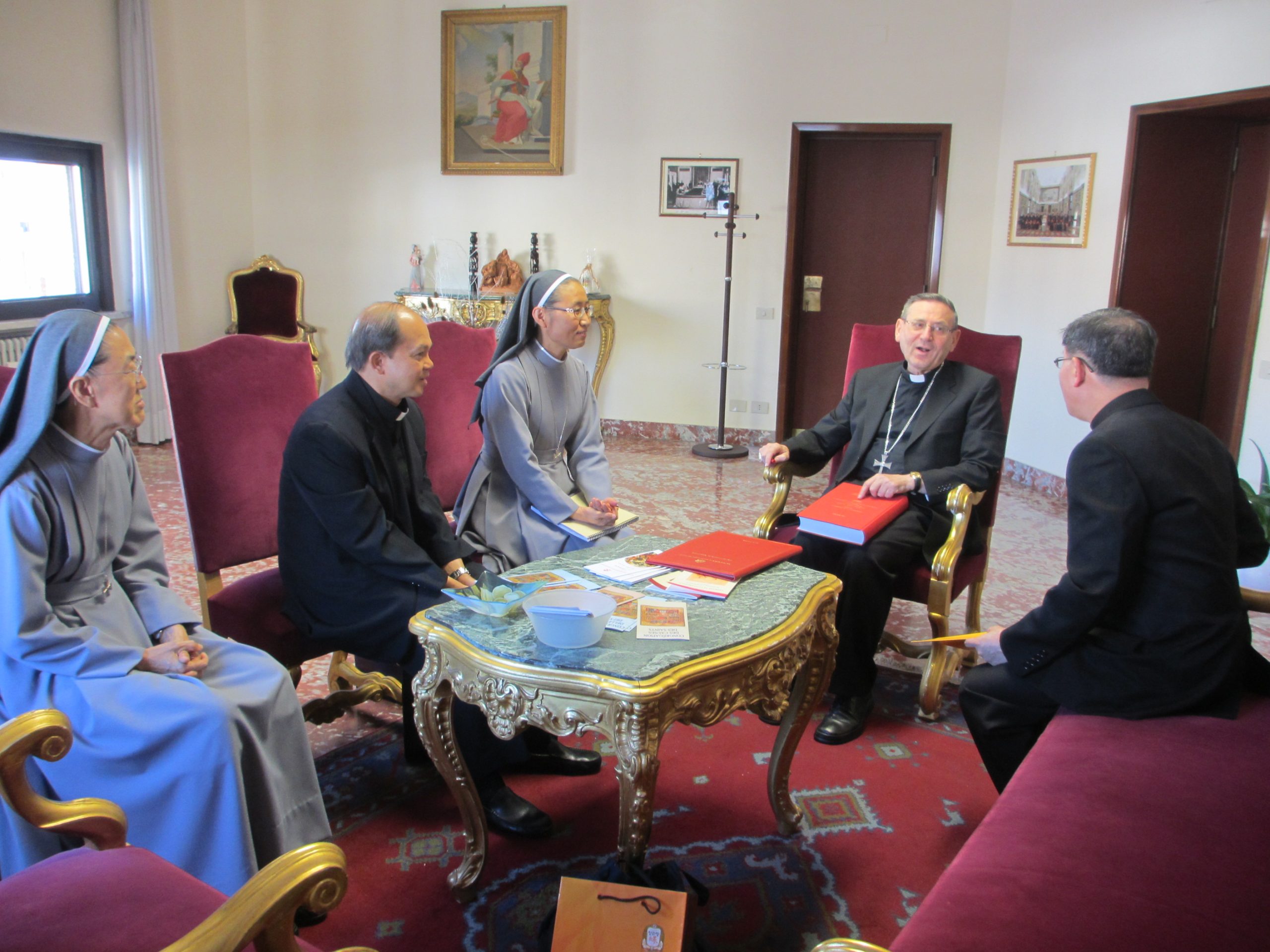
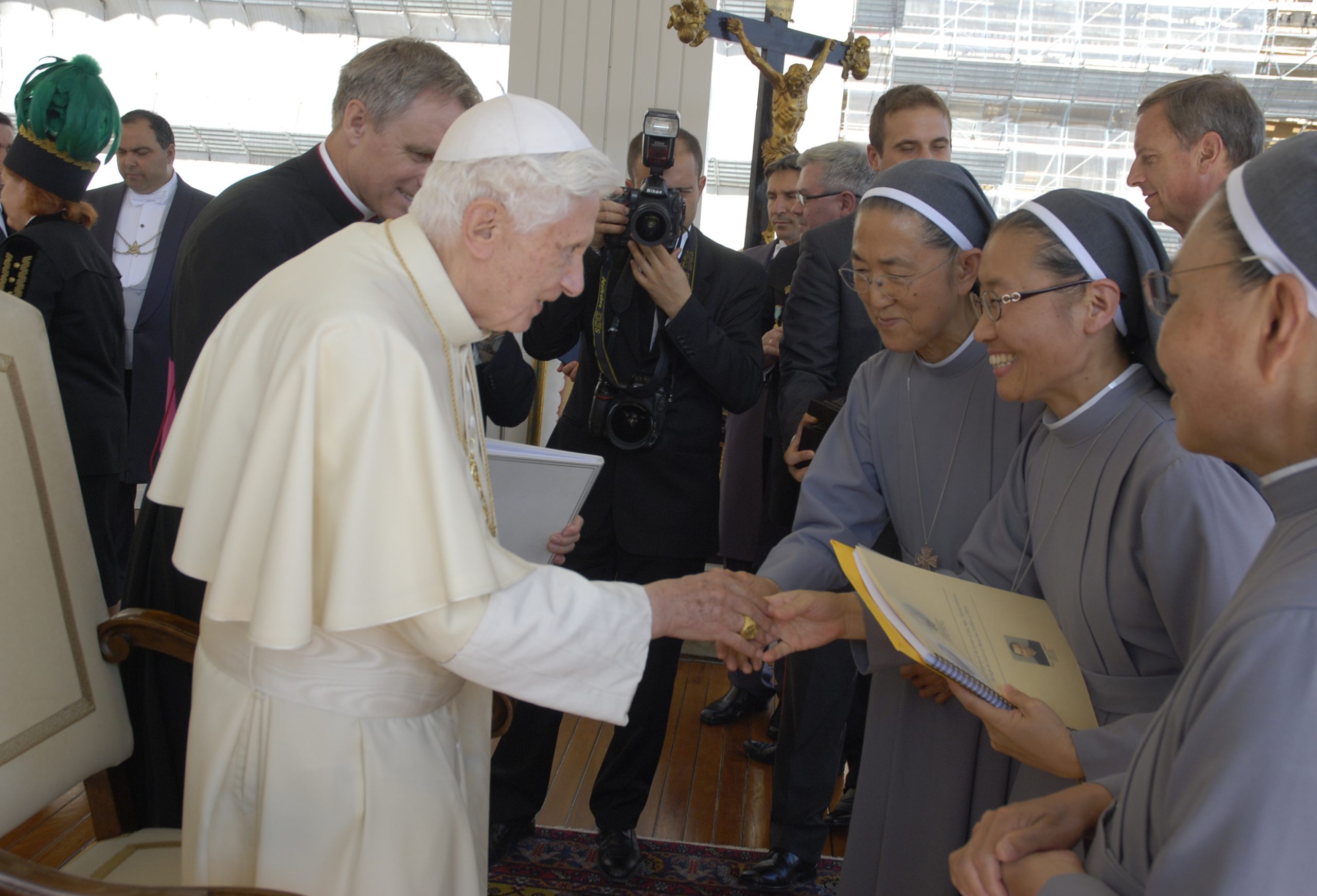
TIMELINE OF THE CAUSE OF BEATIFICATION
July 28, 2003
Sister Michaela Kim, Superior General of the Sisters of Mary, writes to His Eminence Jaime Cardinal Sin, Archbishop of Manila, to initiate the diocesan process for the Cause of Beatification and Canonization of Msgr. Aloysius Schwartz.
August 2, 2003
Archbishop Jaime Cardinal Sin replies to Sister Michaela Kim and approves the request of the Sisters of Mary.
September 15, 2003
Archbishop of Manila sends a letter to His Eminence Jose Cardinal Saraiva Martins, Prefect of the Congregation for the Causes of Saints, requesting the nihil obstat.
November 27, 2003
The Nihil Obstat is granted for the Opening of the Cause
December 10, 2003
Formal Opening Ceremony of the Diocesan Inquiry
December 11, 2003
Start of interrogation of Witnesses to the Heroic Virtues practiced by Msgr. Schwartz
May 29, 2004
Closing Ceremony of the Diocesan Inquiry
June 9, 2004
Submission of the gathered documents in Rome
May 20, 2005
The Congregation for the Causes of Saints grants the Decree of Validity of the Process.
October 6, 2012
The Positio super Vita, Virtutibus et Fama Sanctitatis is submitted to the Prefect of the Congregation for the Causes of Saints, His Eminence Angelo Cardinal Amato, SDB
March 6, 2014
The theological sensors of the Congress of the Congregation of the Causes of Saints unanimously approved the heroic virtues of the Servant of God
December 16, 2014
The College of Cardinals approved the heroic virtues of Msgr. Aloysius Schwartz.
January 22, 2014
Pope Francis signed the decree recognizing the heroic virtues of Msgr. Aloysius Schwartz, thus bestowing on him the title of “Venerable”
October 10, 2012
on the eve of the opening of the Year of Faith to Commemorate the 50th year of the Opening of the Vatican Ecumenical Council II, Sr. Maria Cho, the superior general of the Sisters of Mary together with Sr. Michaela Kim, former superior general and Sr. Elena, the vicaress general, were given the special privilege to receive the Apostolic Blessing personally from His Holiness, Pope Benedict XVI.
